DevOps Patterns & Antipatterns for Continuous Software Updates
A presentation at GIDS.CLOUD Live by Baruch Sadogursky

DevOps Patterns & Antipatterns for Continuous Software Updates “What can possibly go wrong?!”
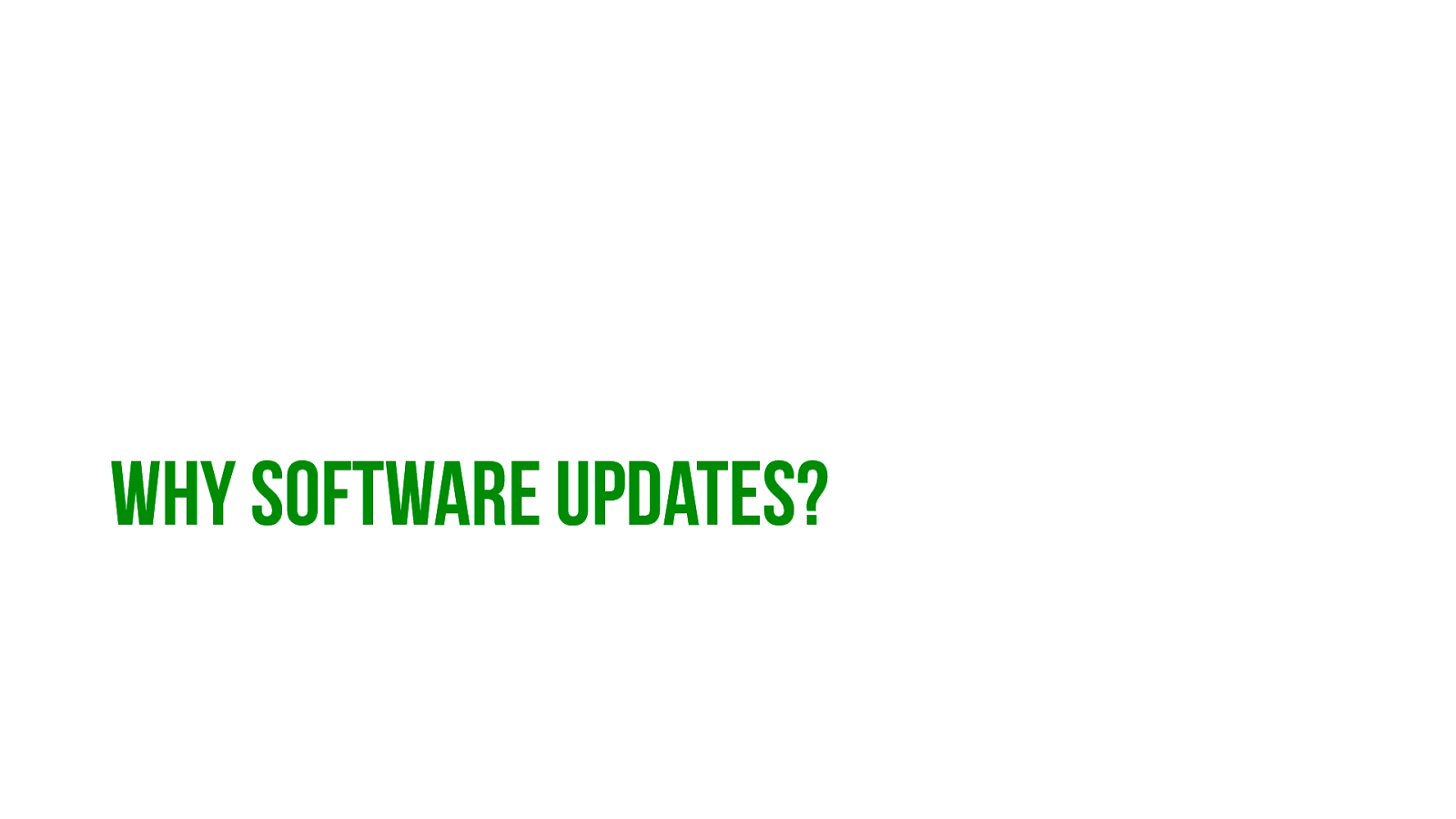
Why software updates?
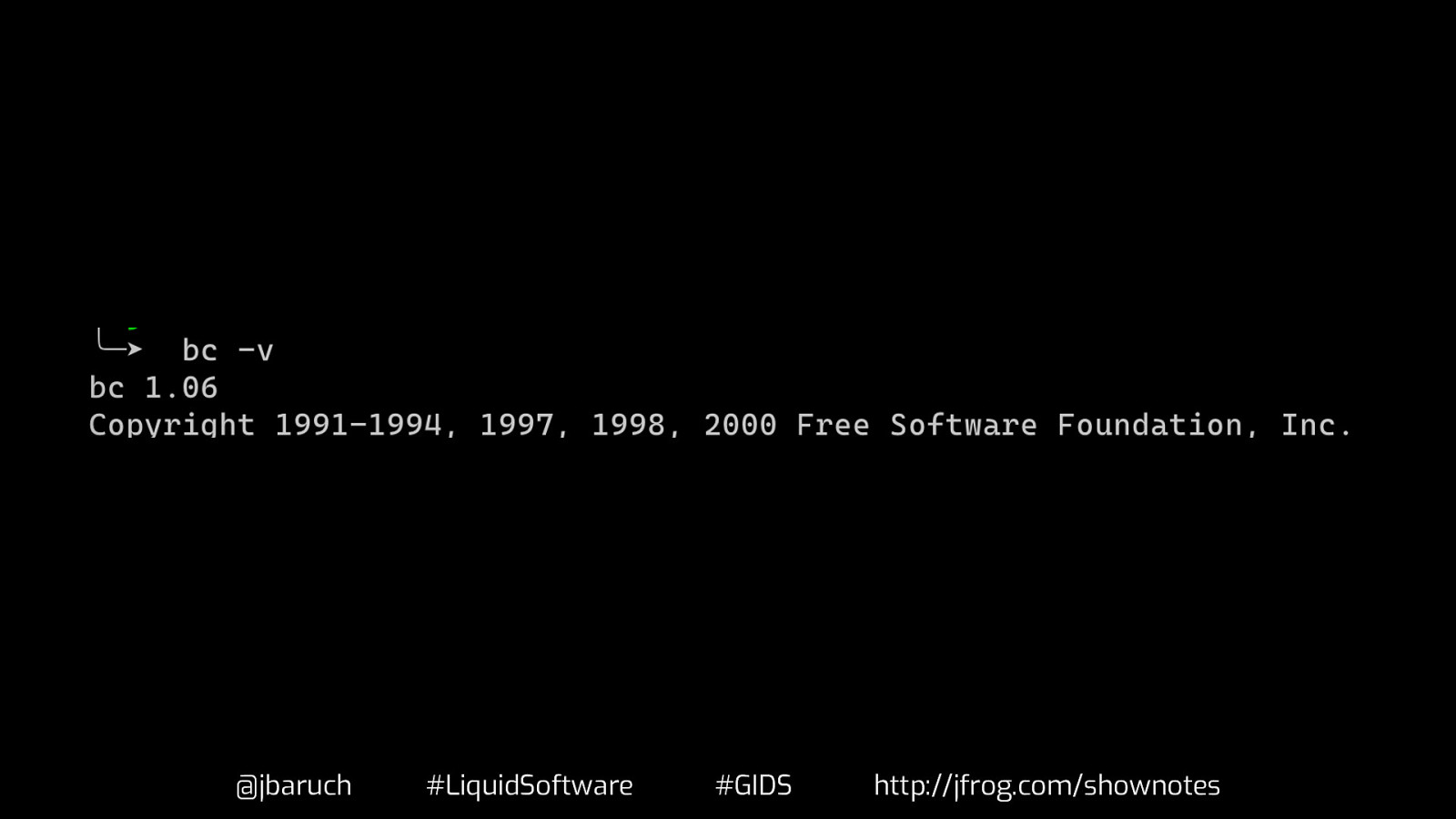
@jbaruch #LiquidSoftware #GIDS http://jfrog.com/shownotes
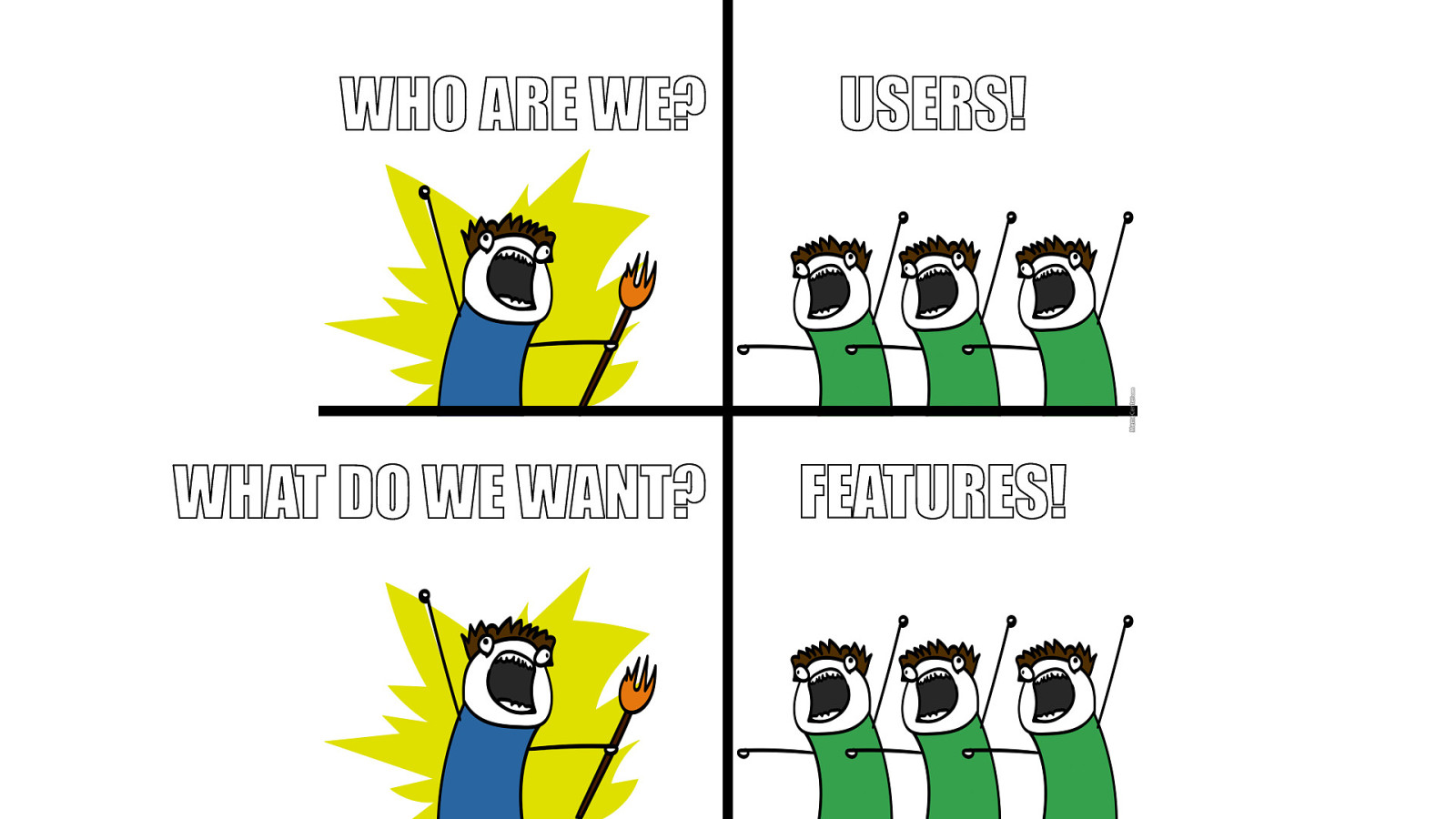
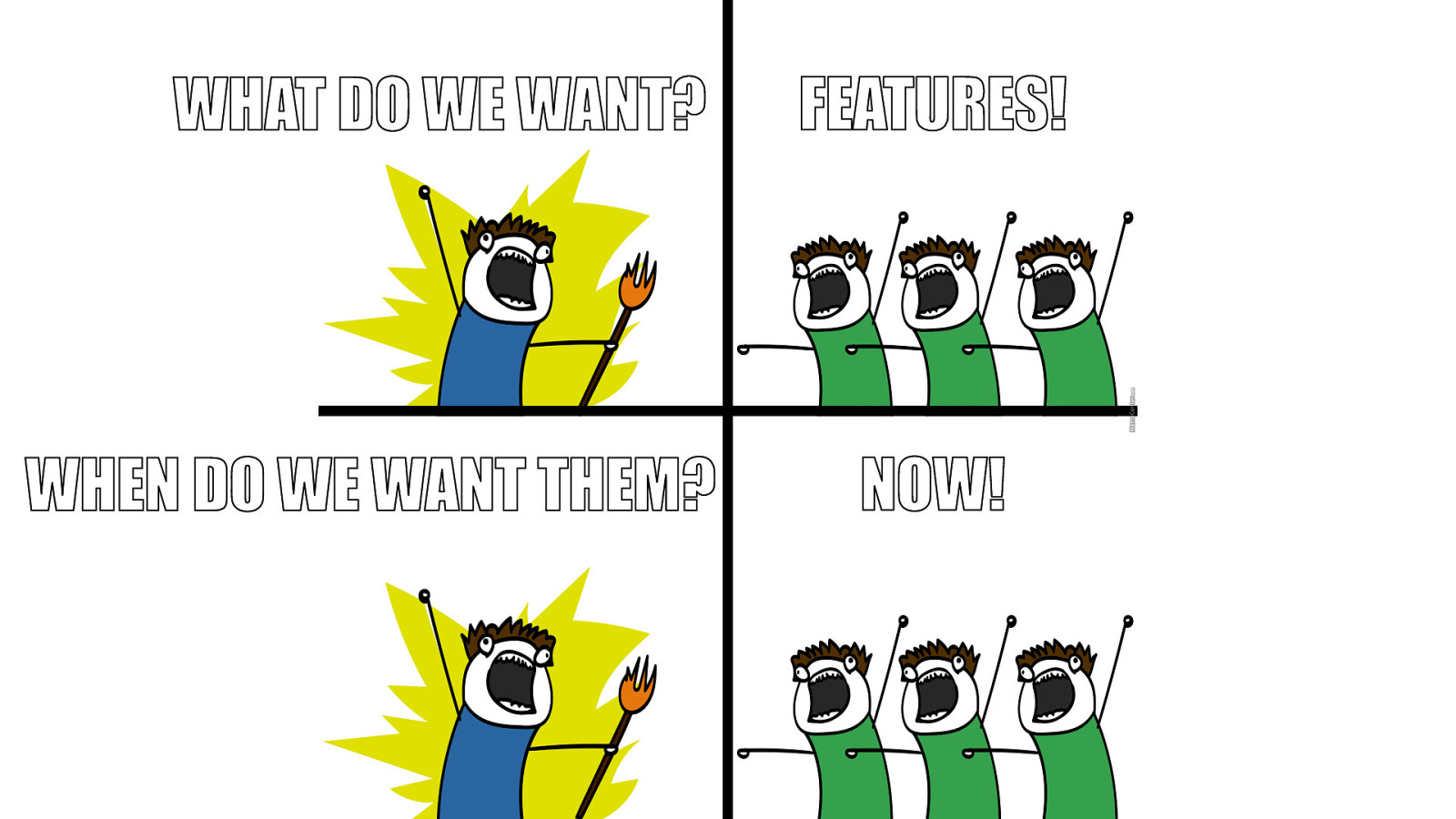

“As every company become a software company, Security vulnerabilities are the new oil spills” @jbaruch #LiquidSoftware #GIDS http://jfrog.com/shownotes

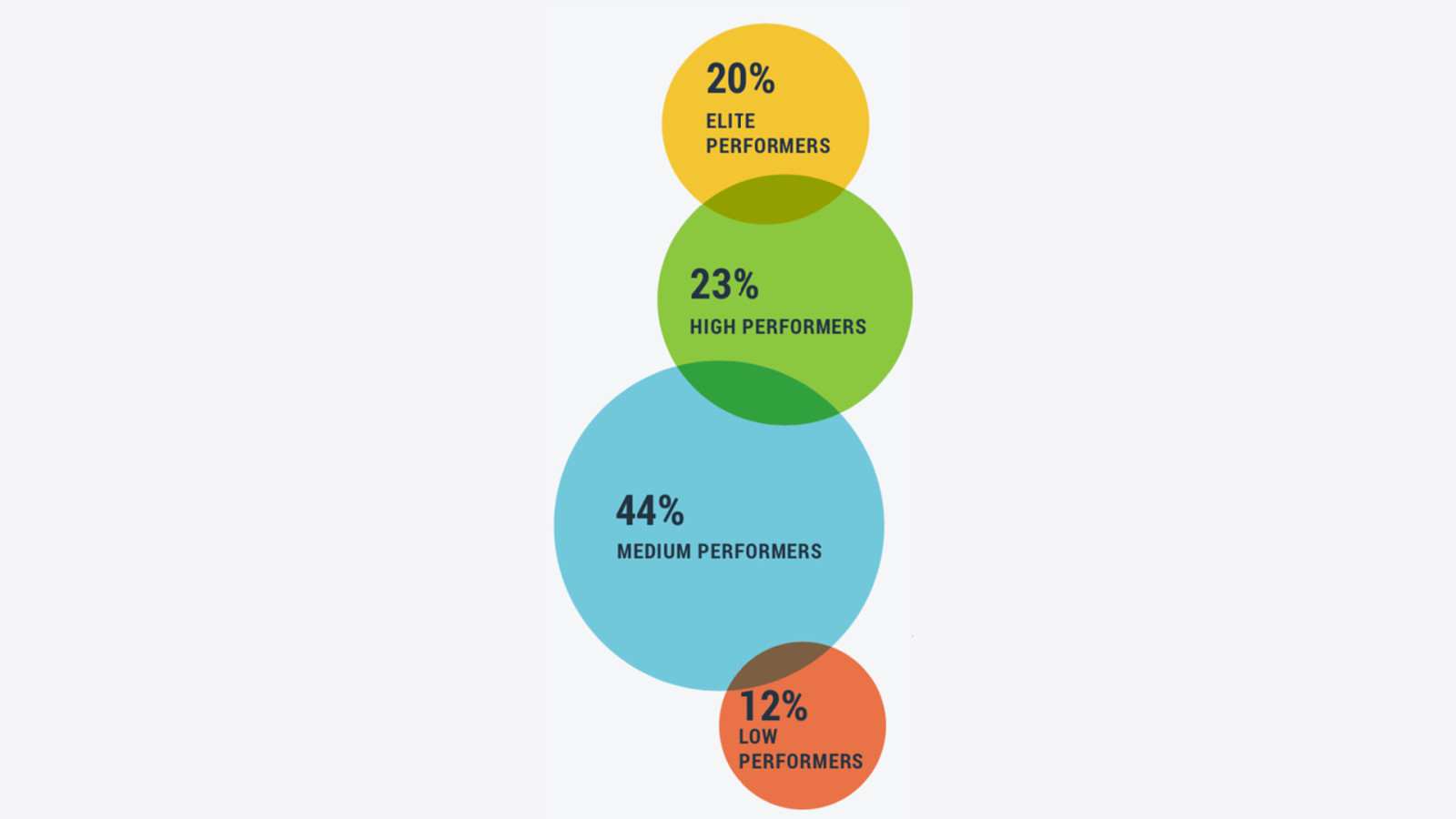
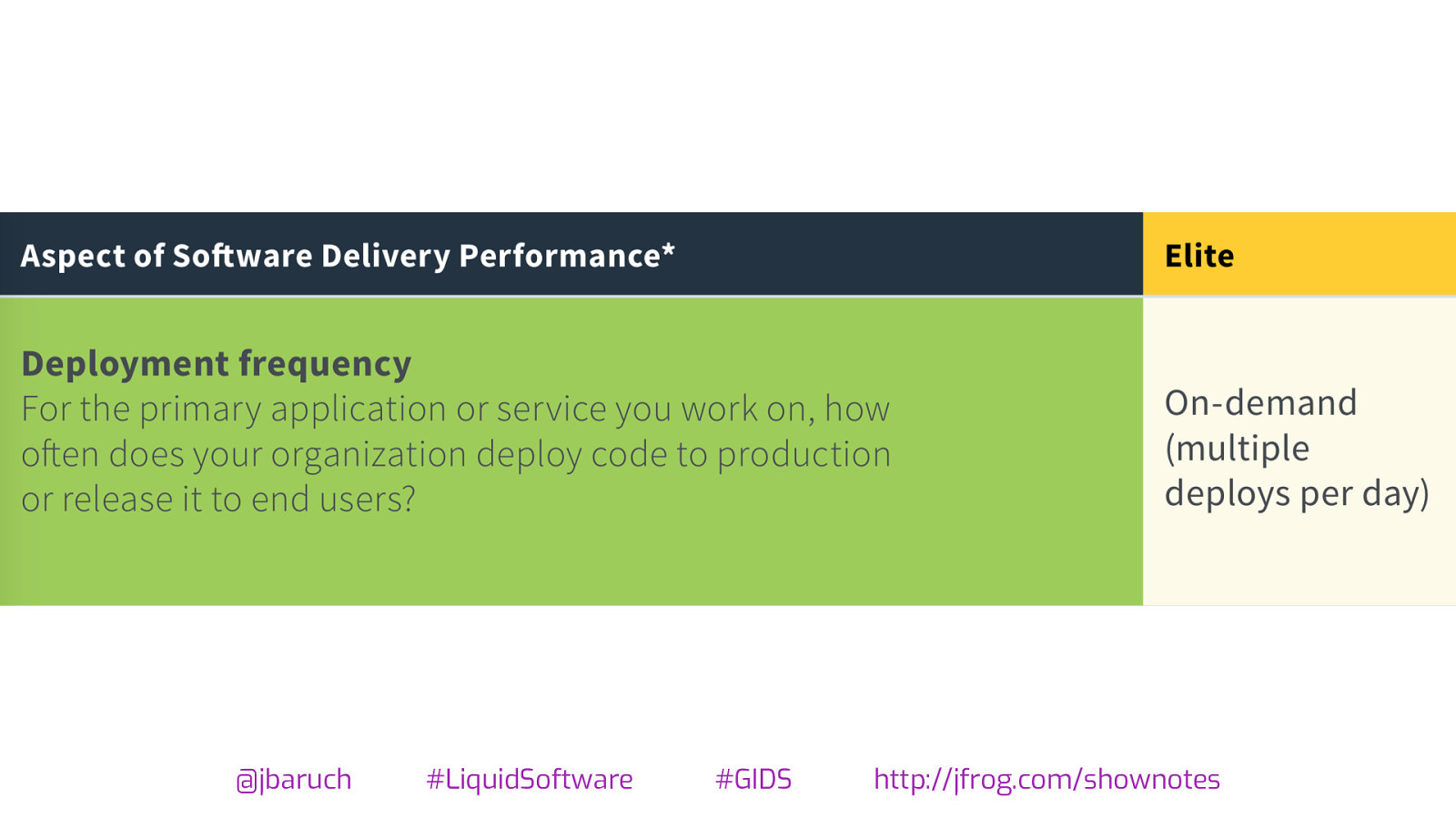
@jbaruch #LiquidSoftware #GIDS http://jfrog.com/shownotes
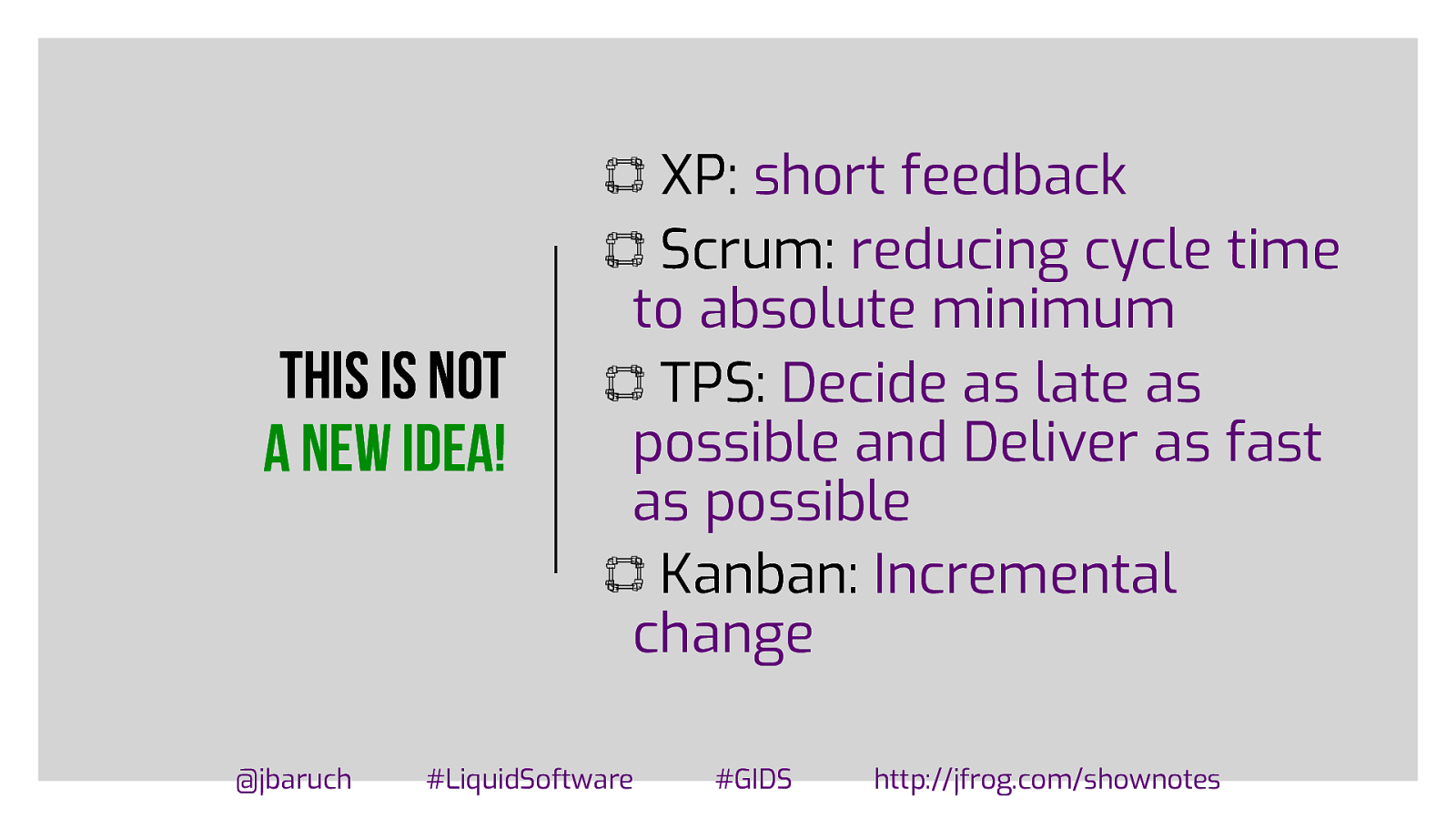
This is not a new idea! @jbaruch XP: short feedback Scrum: reducing cycle time to absolute minimum TPS: Decide as late as possible and Deliver as fast as possible Kanban: Incremental change #LiquidSoftware #GIDS http://jfrog.com/shownotes
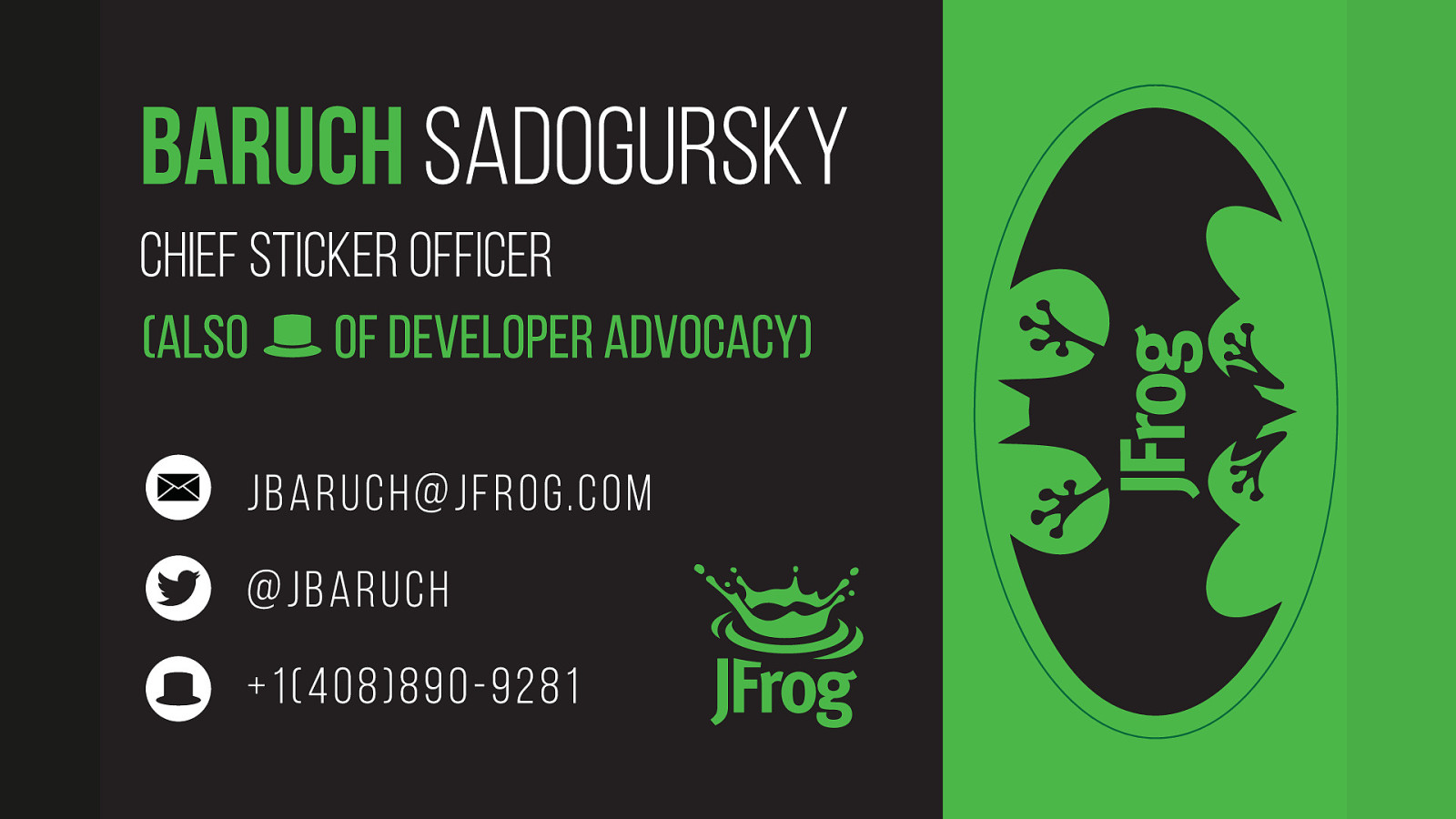
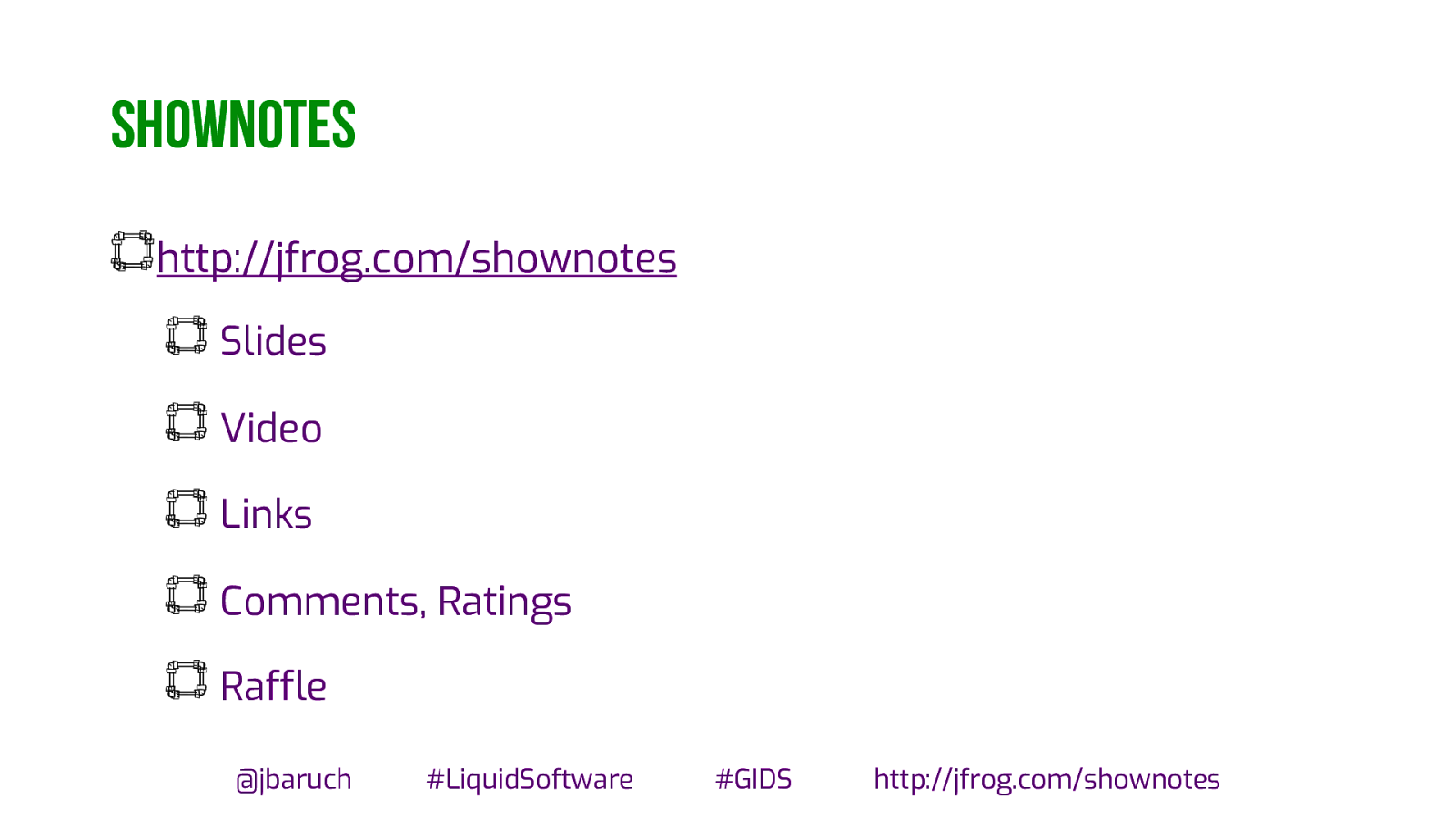
shownotes http://jfrog.com/shownotes Slides Video Links Comments, Ratings Raffle @jbaruch #LiquidSoftware #GIDS http://jfrog.com/shownotes
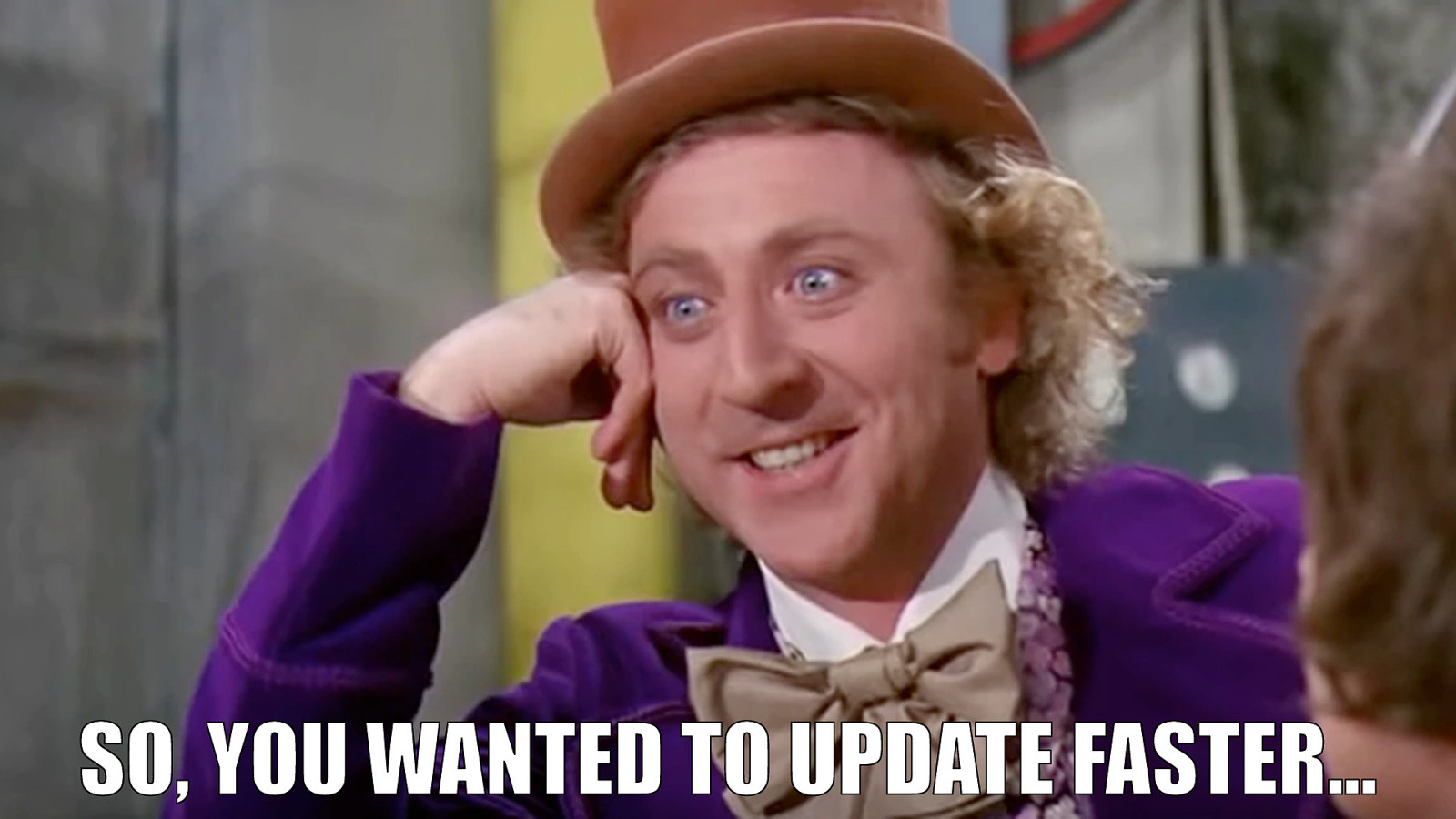
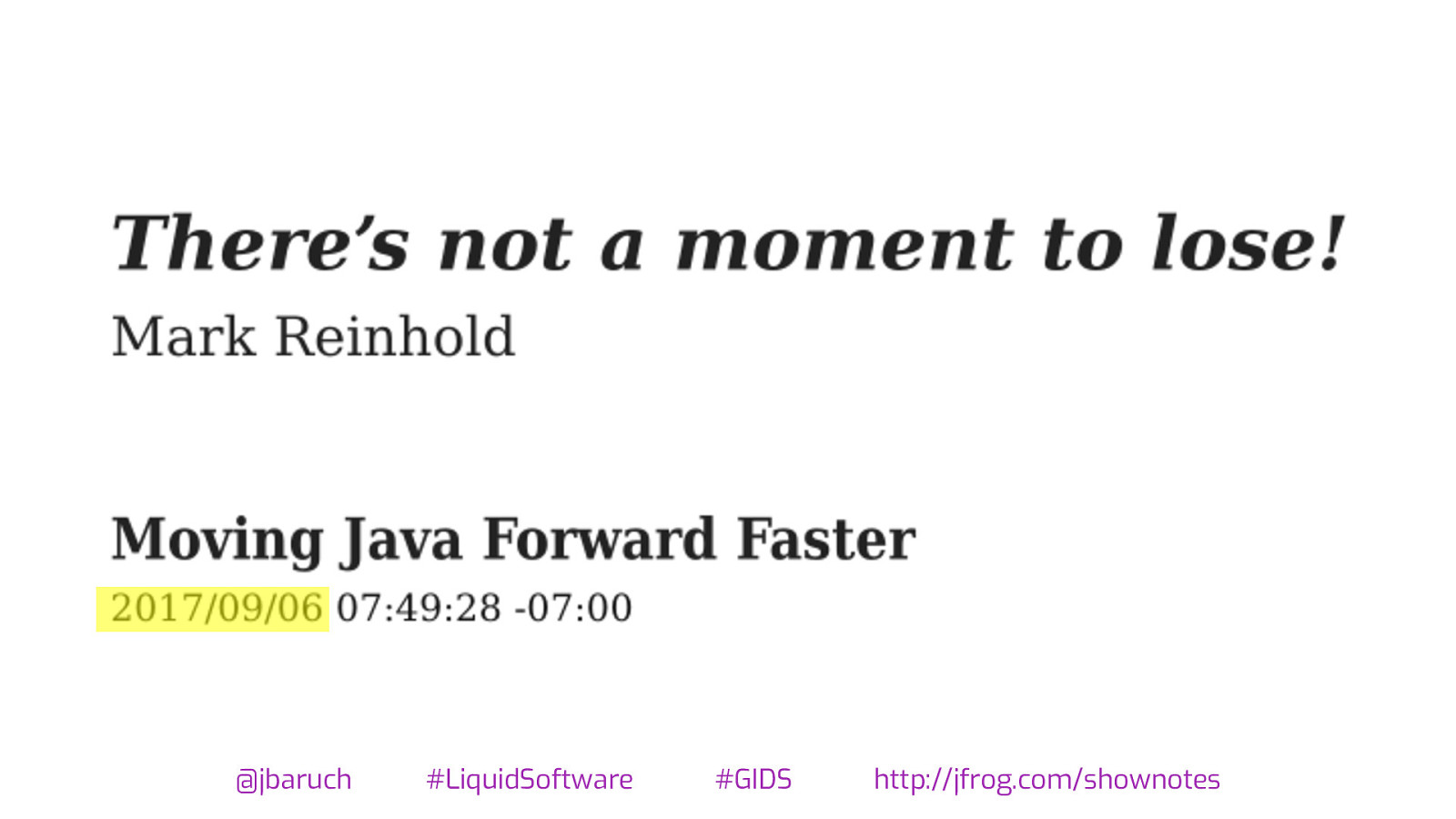
@jbaruch #LiquidSoftware #GIDS http://jfrog.com/shownotes
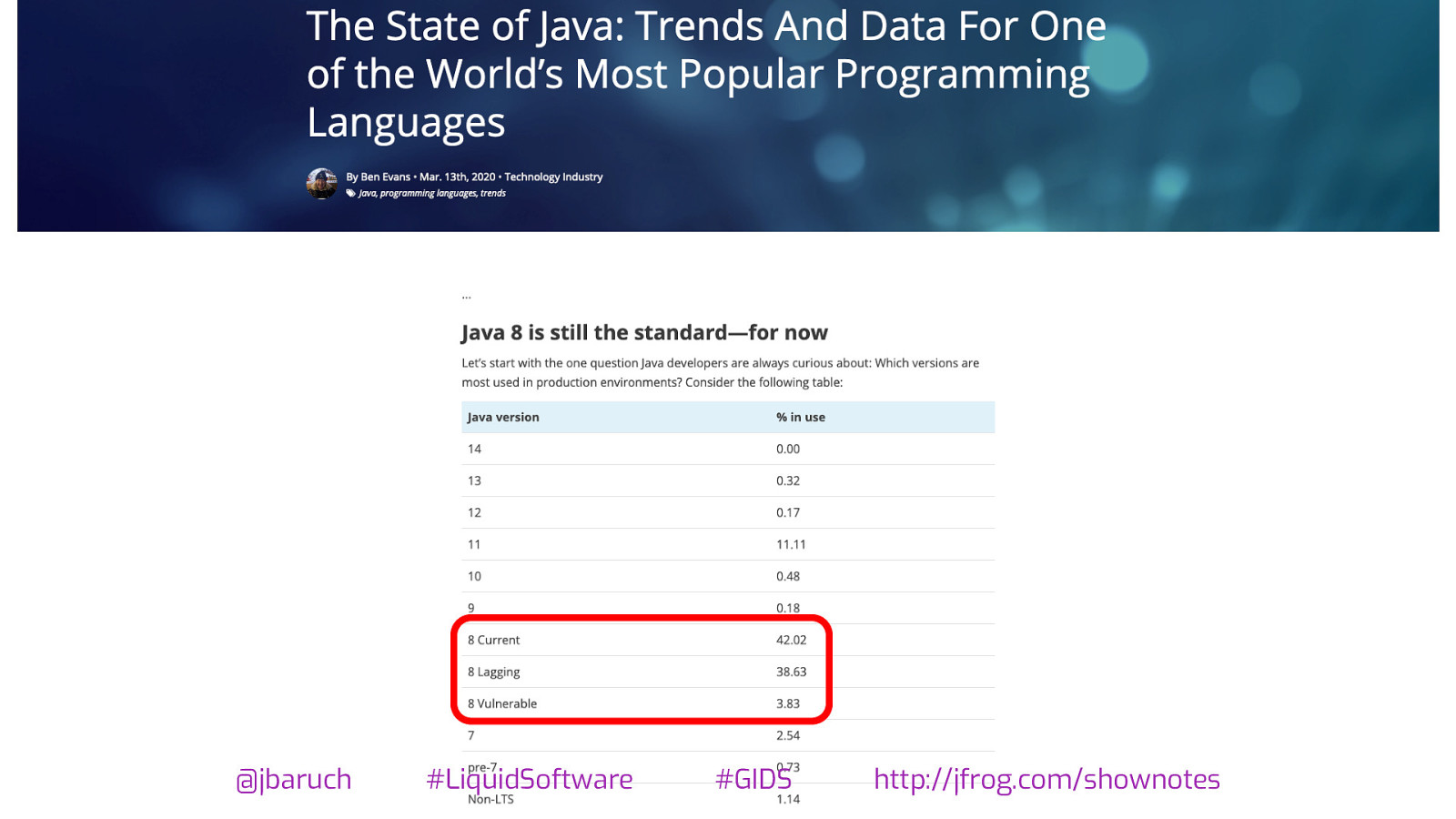
@jbaruch #LiquidSoftware #GIDS http://jfrog.com/shownotes

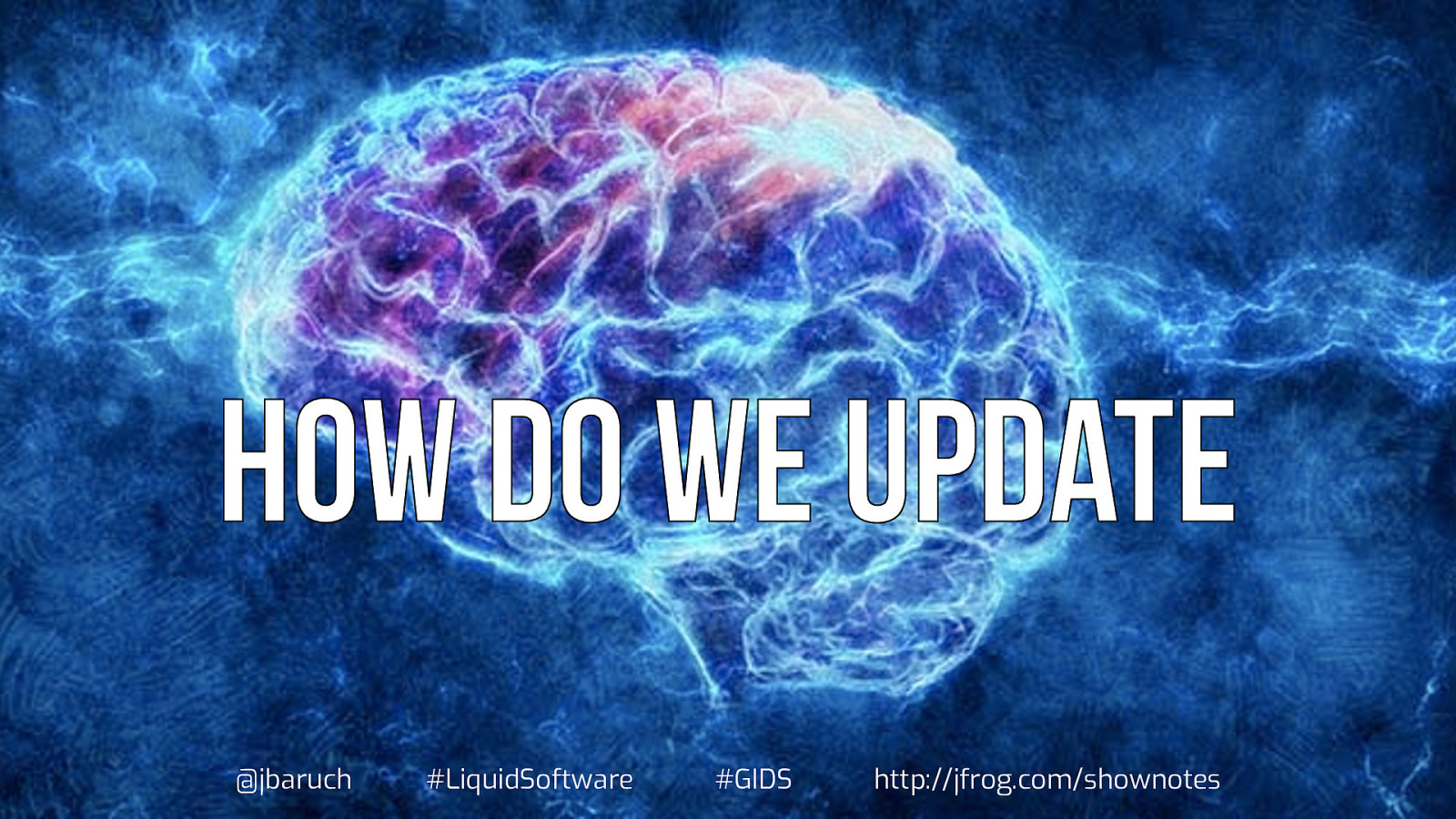
@jbaruch #LiquidSoftware #GIDS http://jfrog.com/shownotes
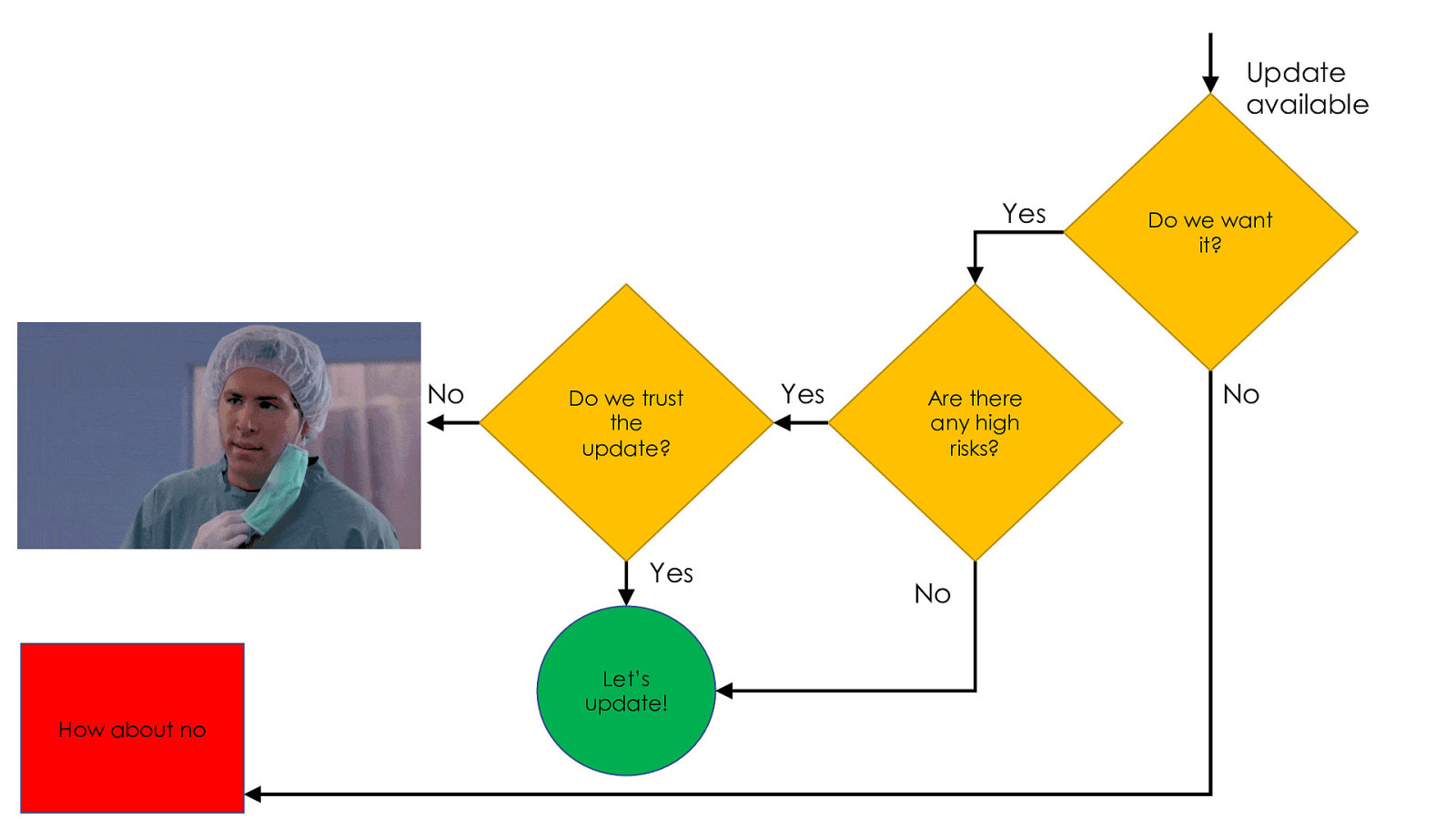
Update available Yes No Do we trust the update? Yes How about no Let’s update! Yes Are there any high risks? No Do we want it? No
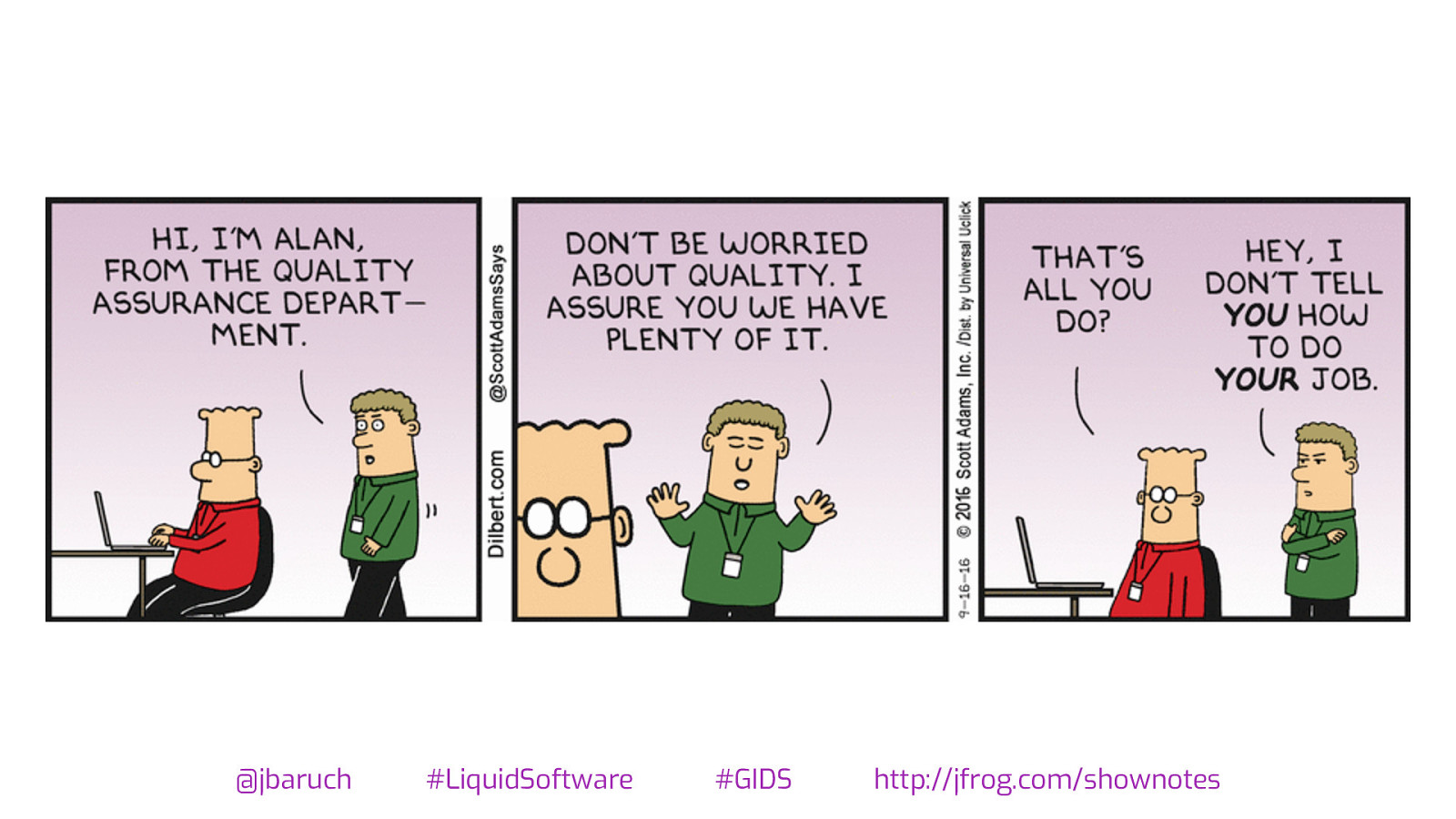
@jbaruch #LiquidSoftware #GIDS http://jfrog.com/shownotes
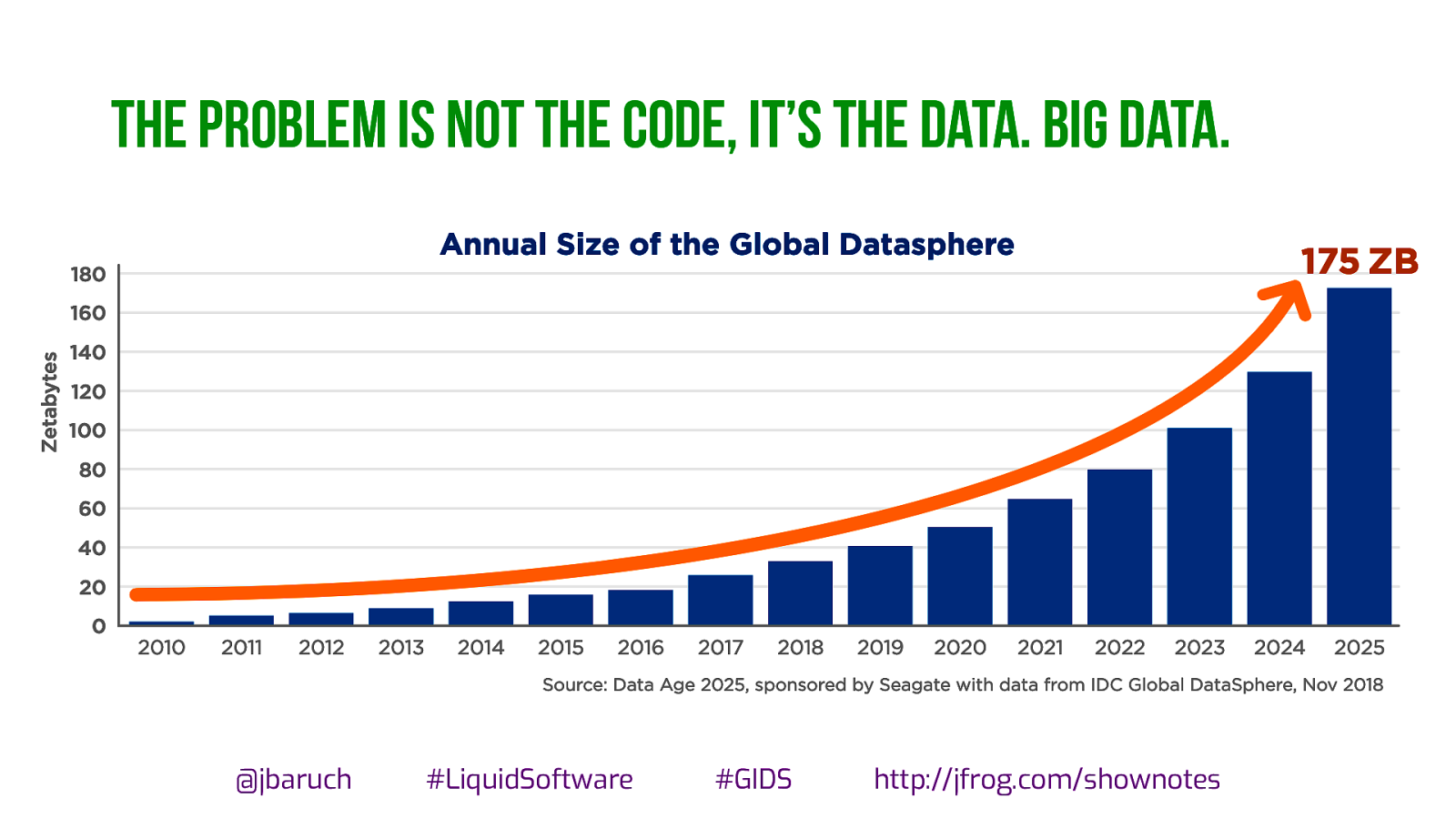
The problem is not the code, it’s the data. Big data. @jbaruch #LiquidSoftware #GIDS http://jfrog.com/shownotes
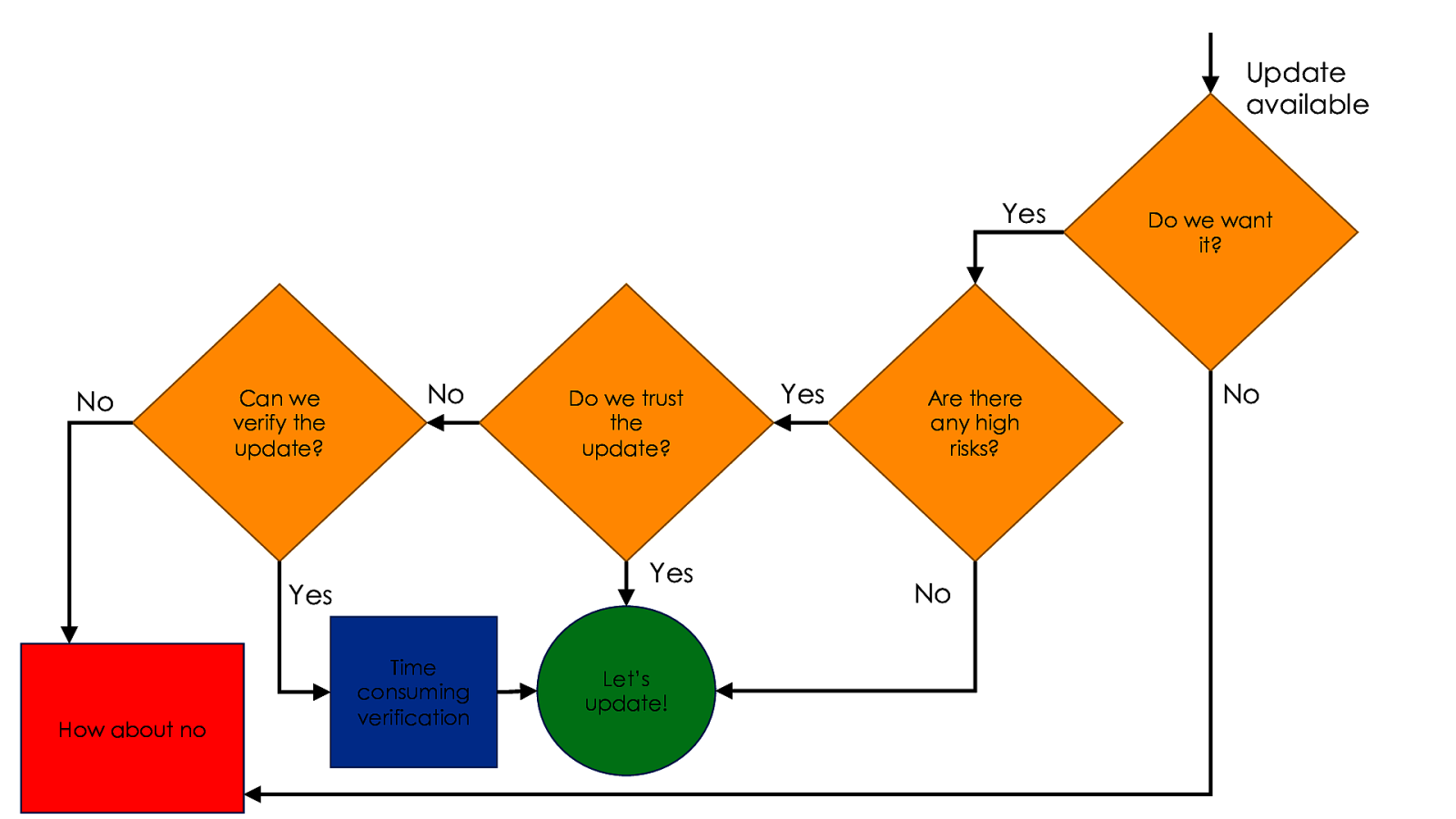
Update available Yes No Can we verify the update? No Yes Yes How about no Do we trust the update? Time consuming verification Let’s update! Yes Are there any high risks? No Do we want it? No

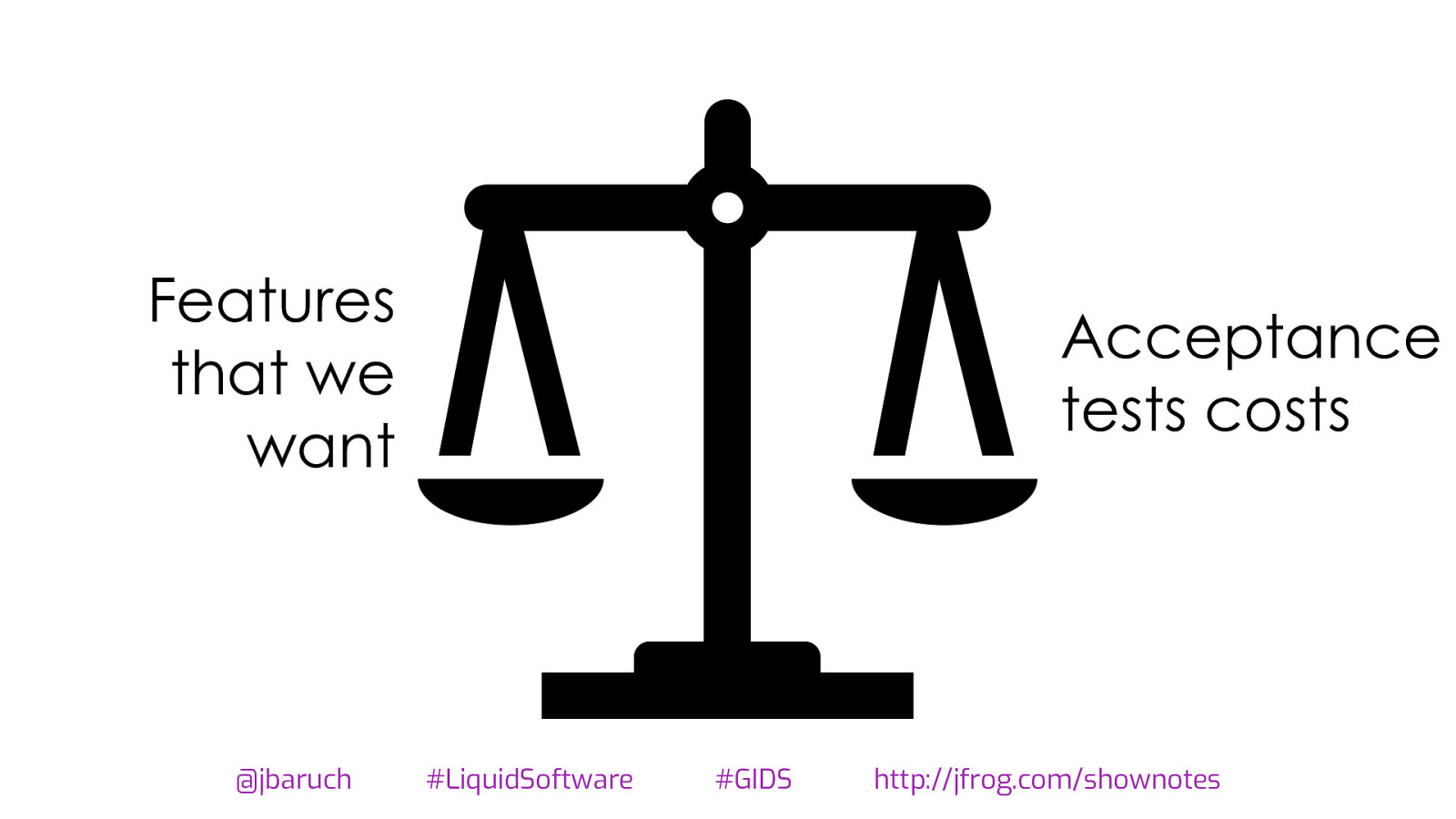
Features that we want @jbaruch Acceptance tests costs #LiquidSoftware #GIDS http://jfrog.com/shownotes
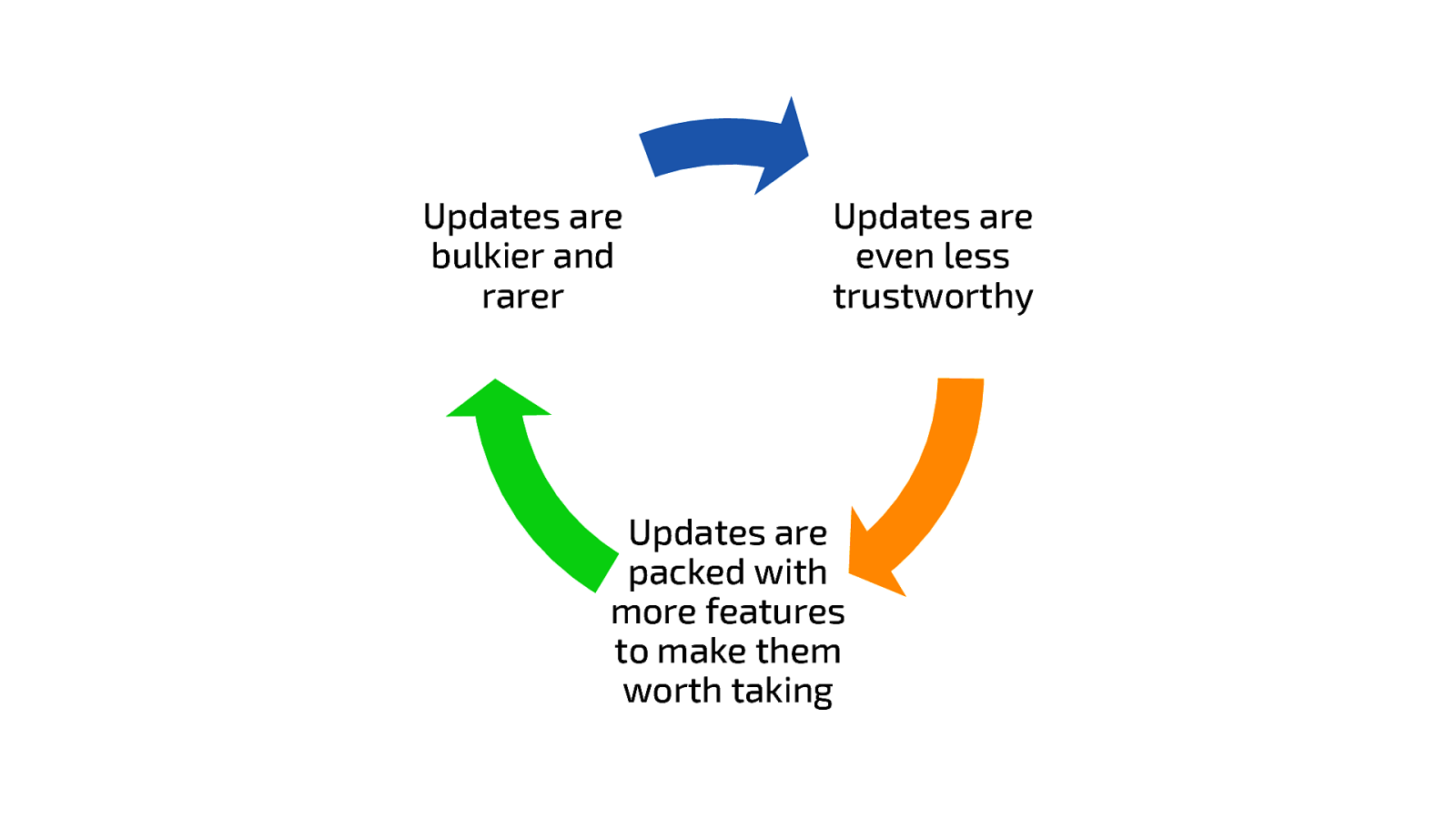
Updates are bulkier and rarer Updates are even less trustworthy Updates are packed with more features to make them worth taking

What can possibly go wrong?
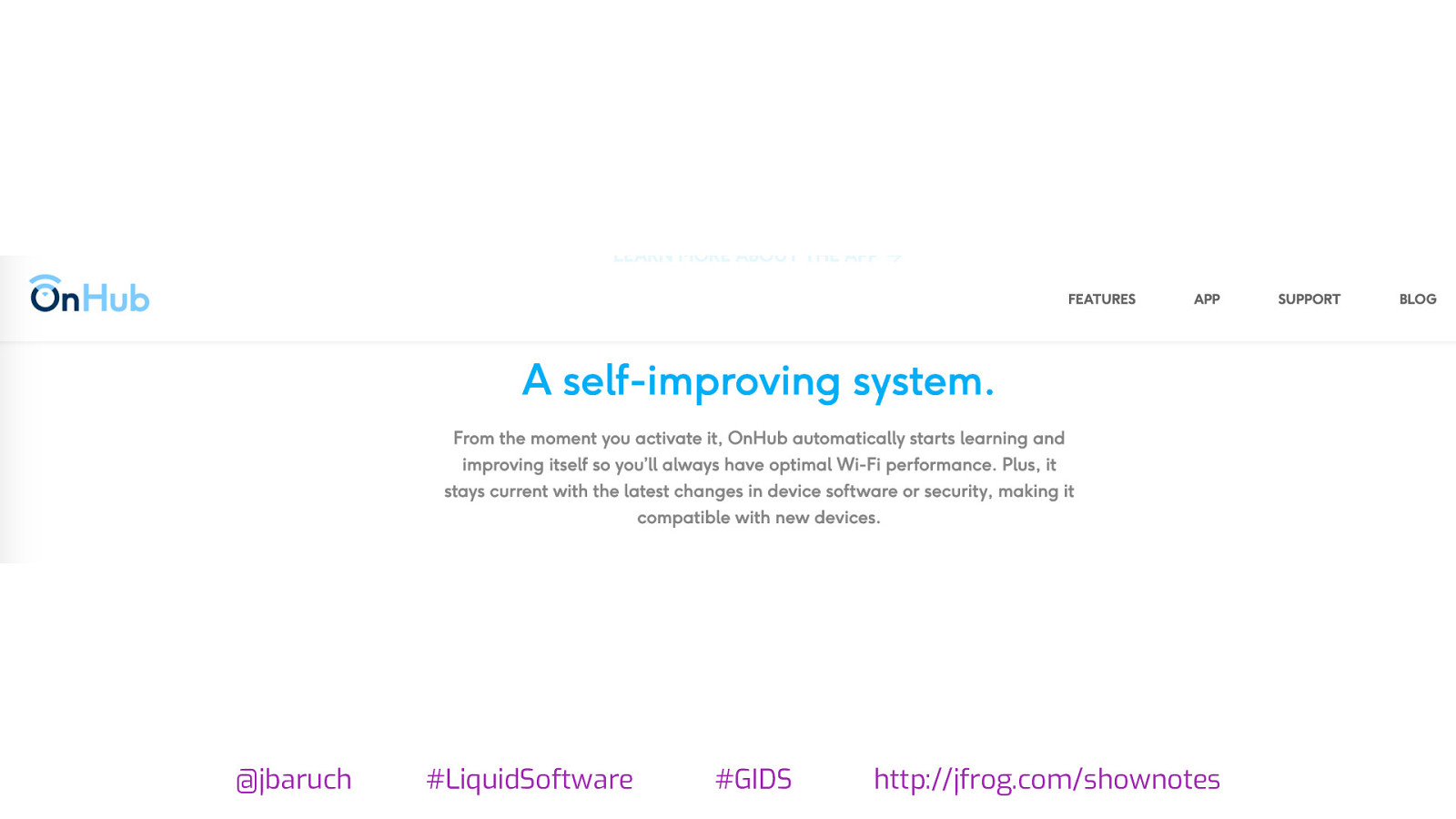
@jbaruch #LiquidSoftware #GIDS http://jfrog.com/shownotes
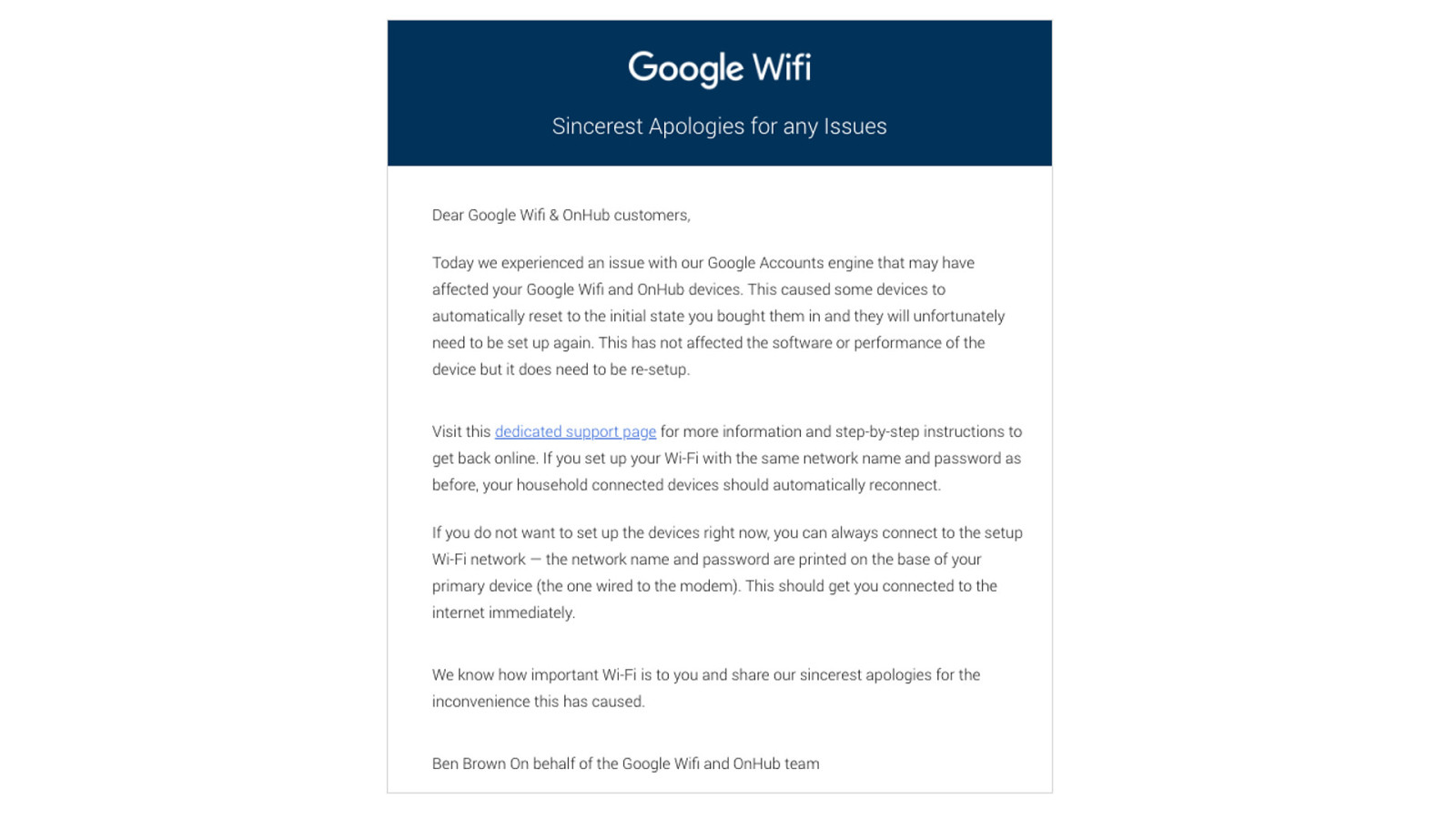
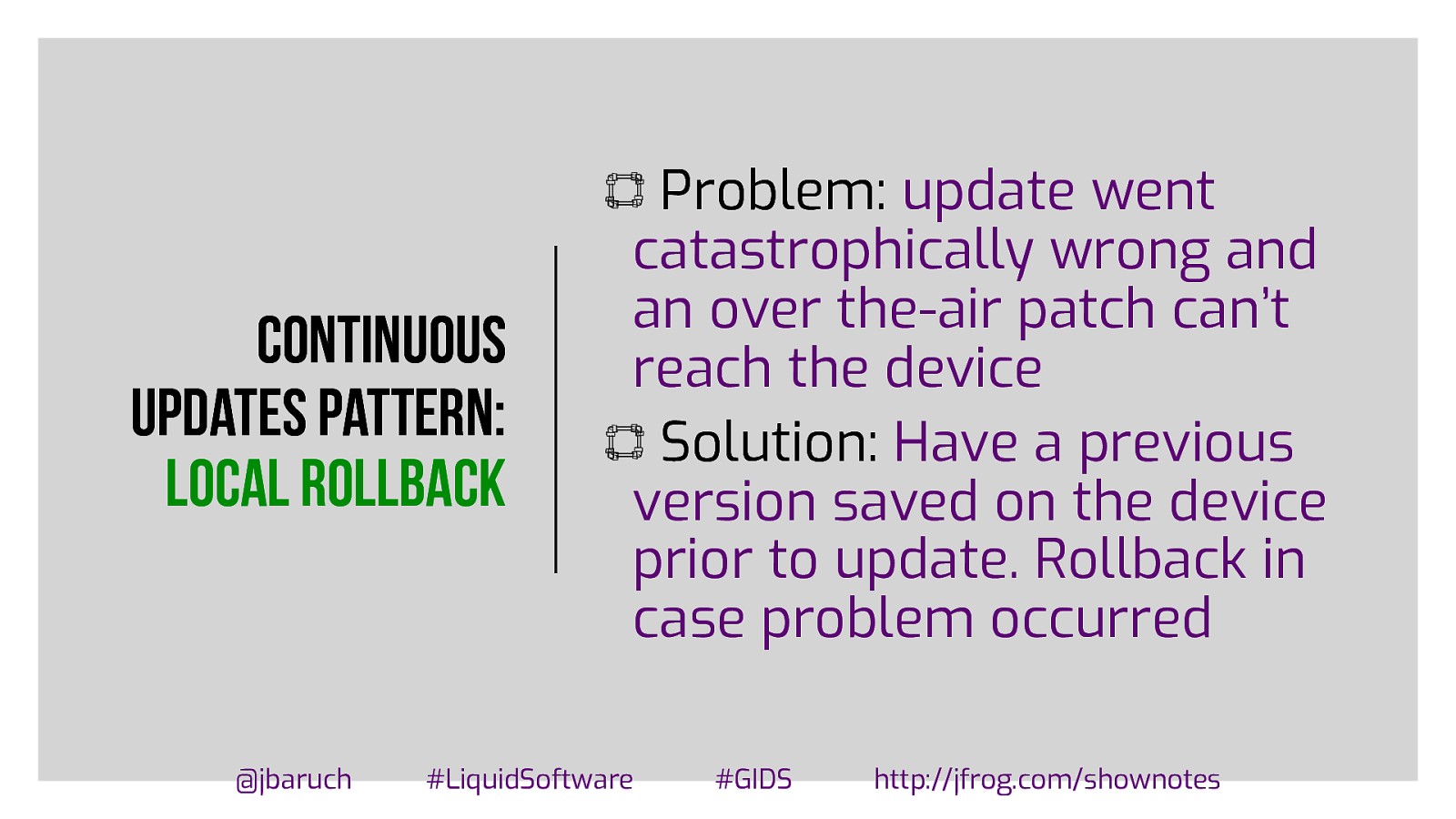
Continuous updates pattern: Local rollback @jbaruch Problem: update went catastrophically wrong and an over the-air patch can’t reach the device Solution: Have a previous version saved on the device prior to update. Rollback in case problem occurred #LiquidSoftware #GIDS http://jfrog.com/shownotes
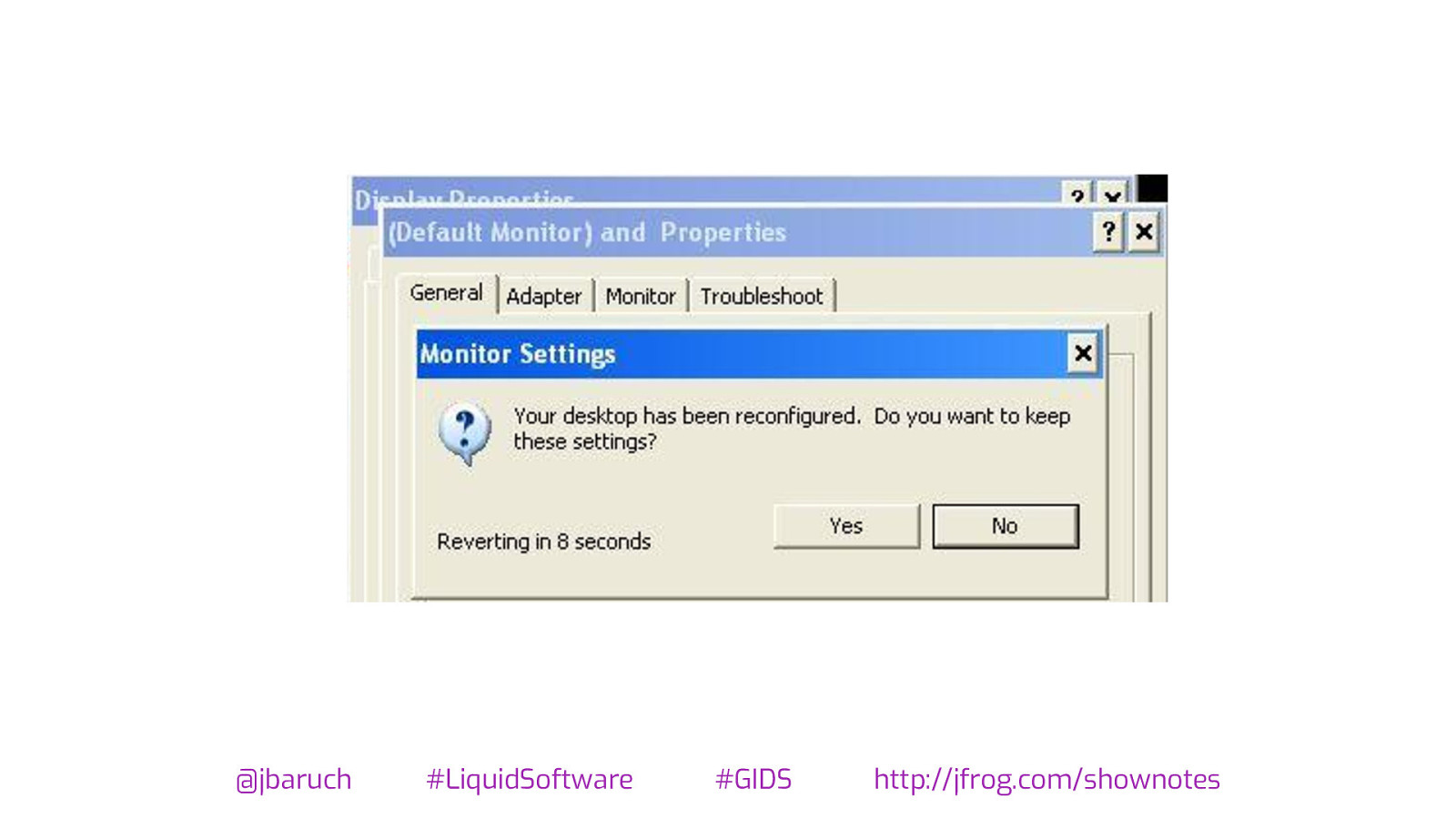
@jbaruch #LiquidSoftware #GIDS http://jfrog.com/shownotes
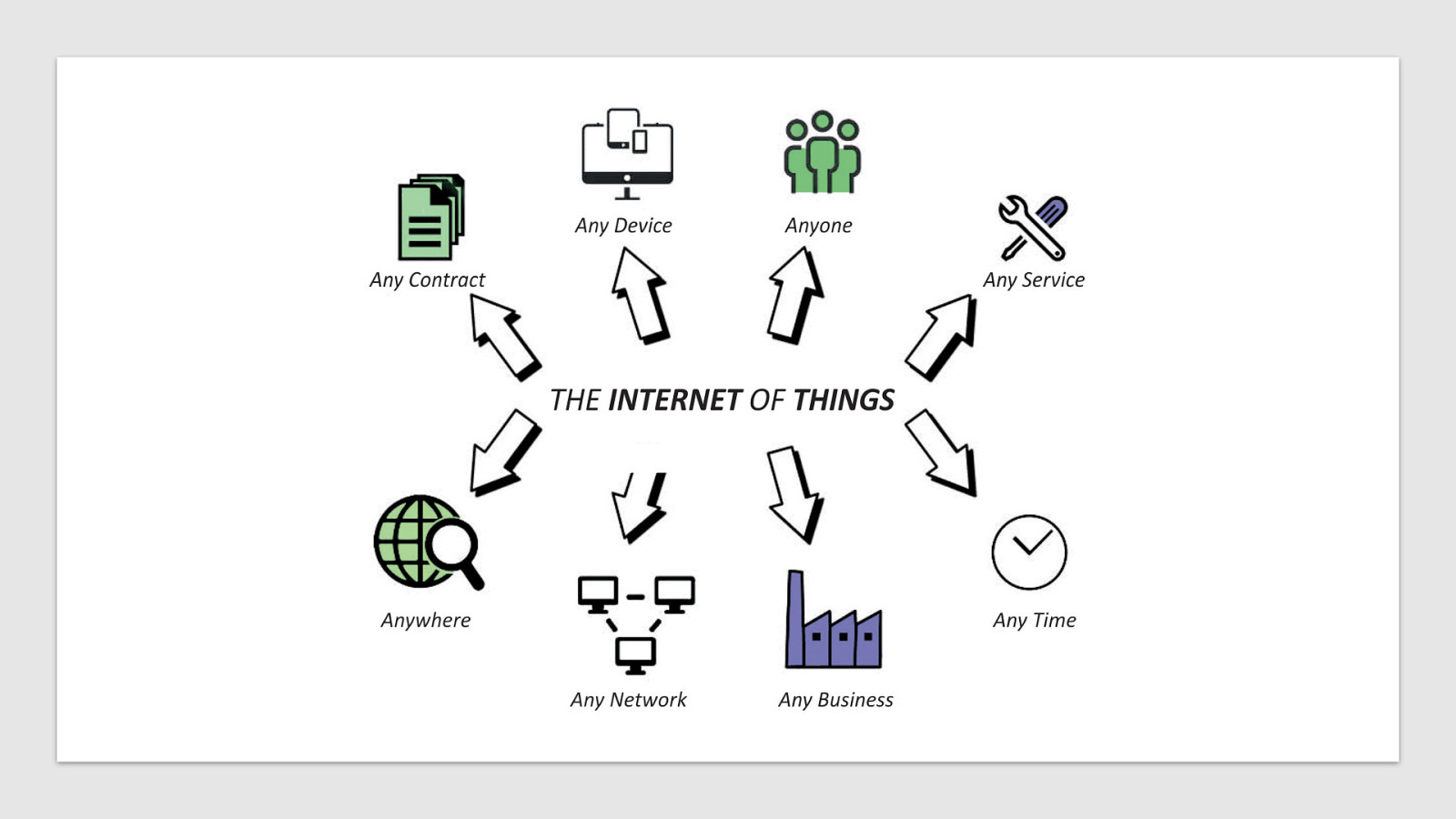
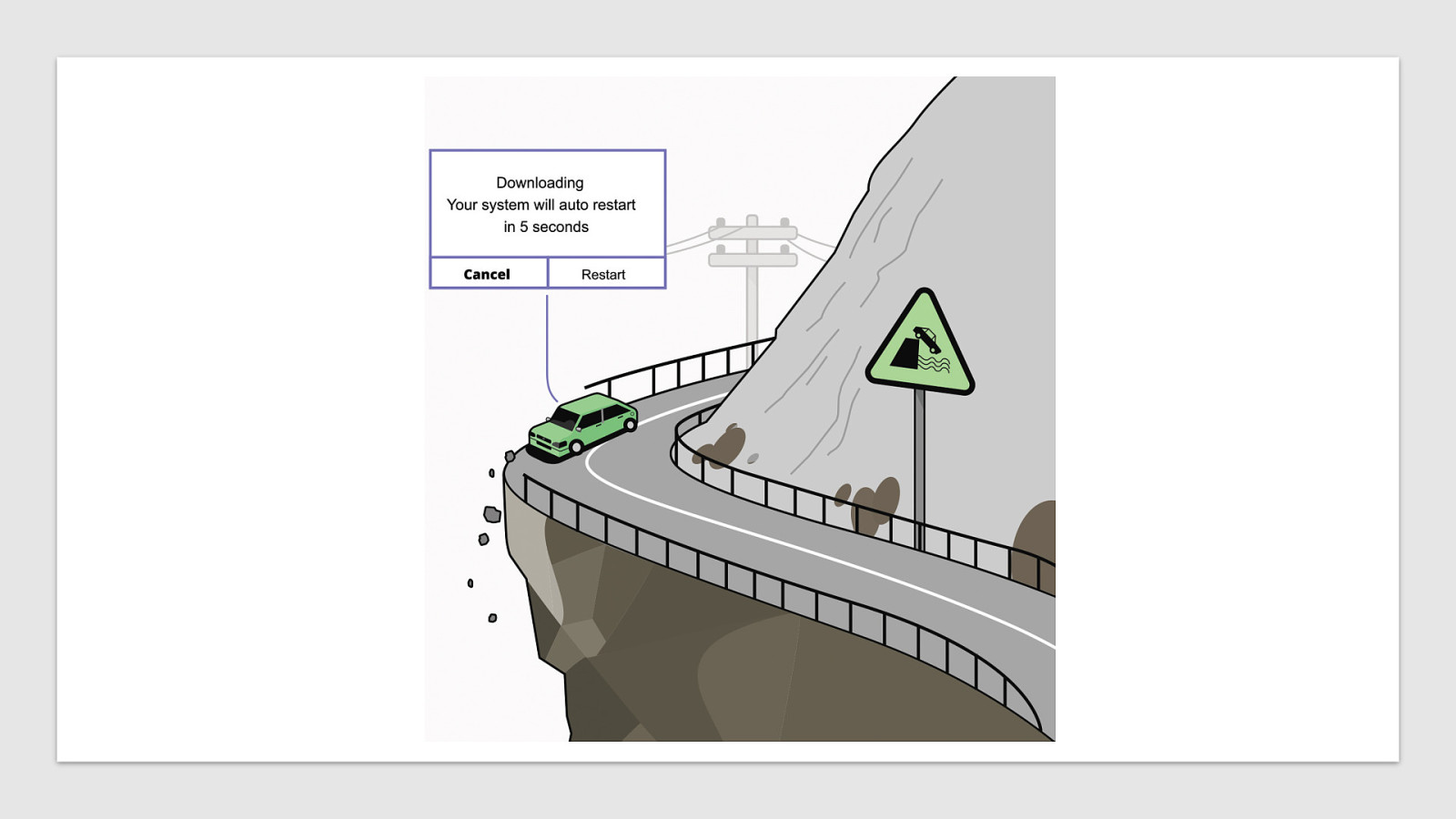

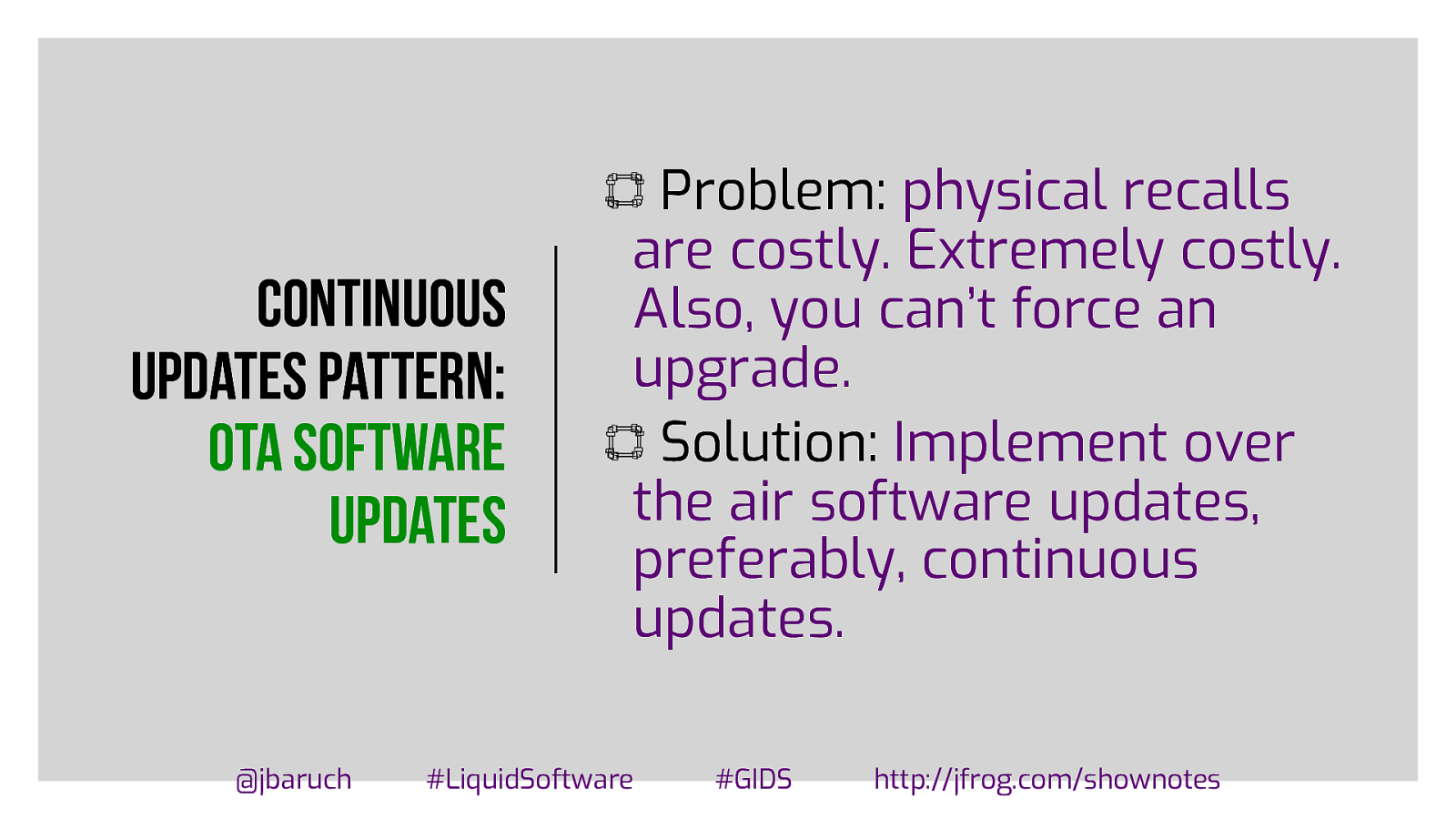
Continuous updates pattern: OTA software updates @jbaruch Problem: physical recalls are costly. Extremely costly. Also, you can’t force an upgrade. Solution: Implement over the air software updates, preferably, continuous updates. #LiquidSoftware #GIDS http://jfrog.com/shownotes
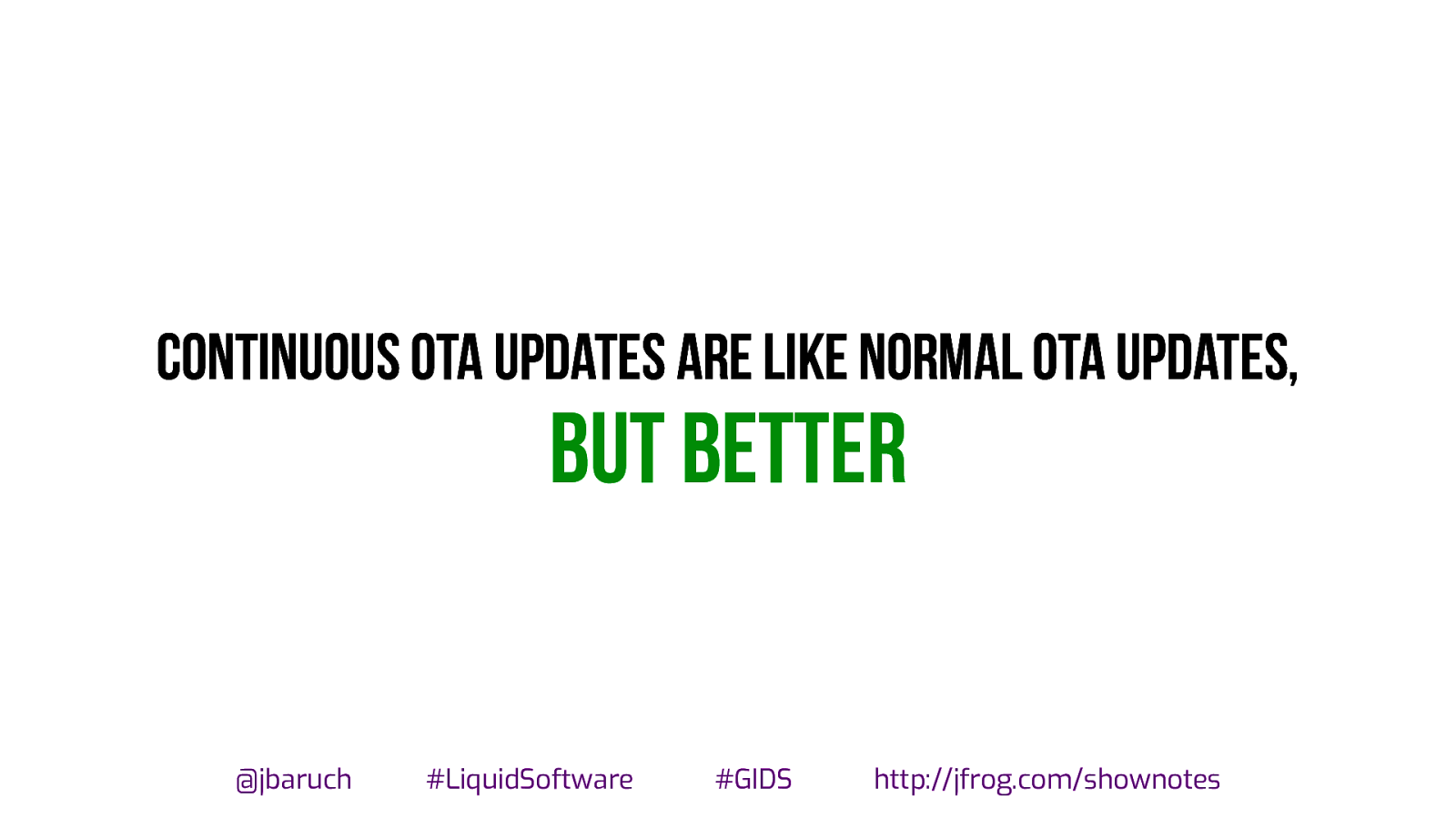
continuous OTA updates are like normal OTA updates, but better @jbaruch #LiquidSoftware #GIDS http://jfrog.com/shownotes
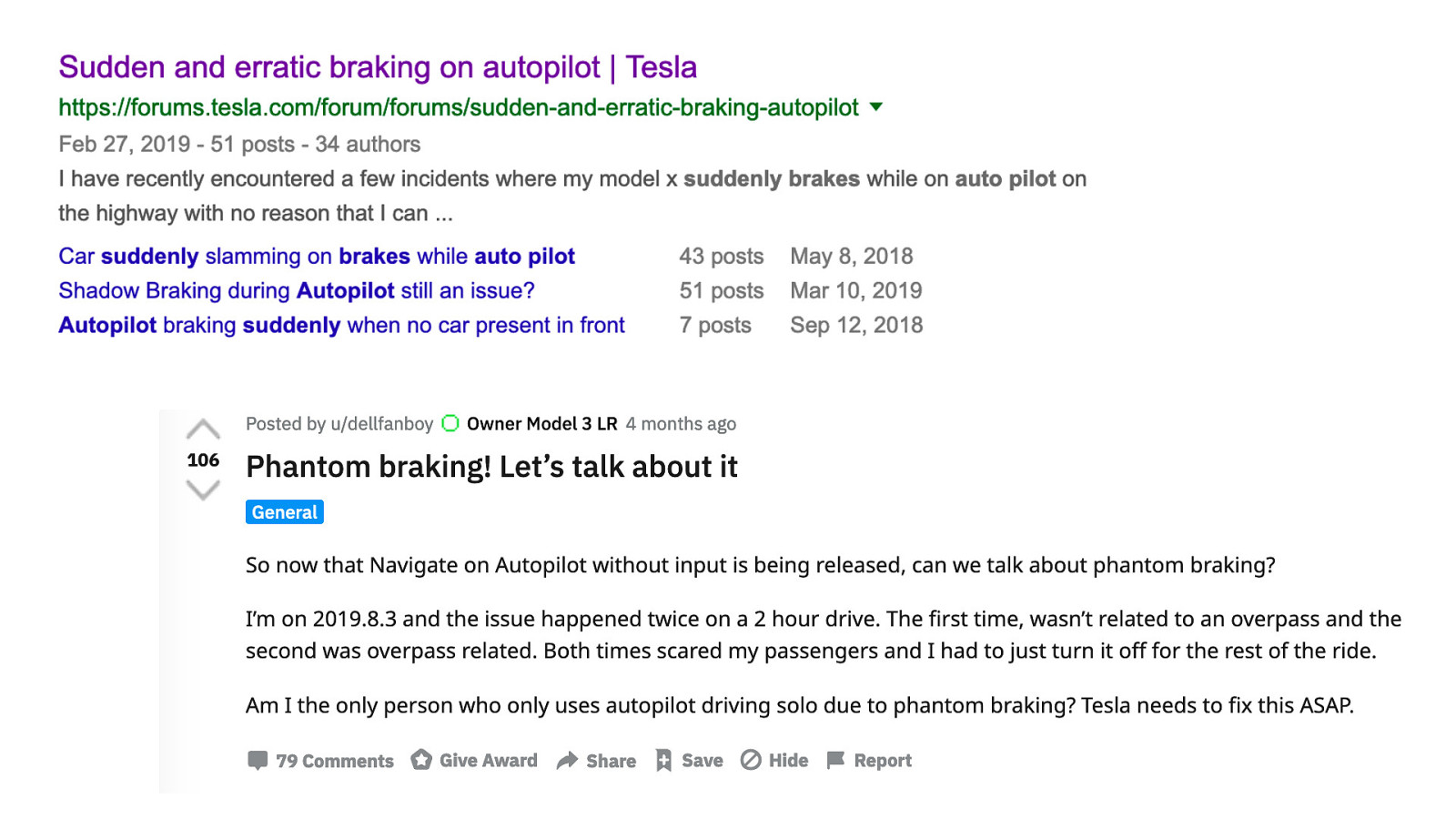
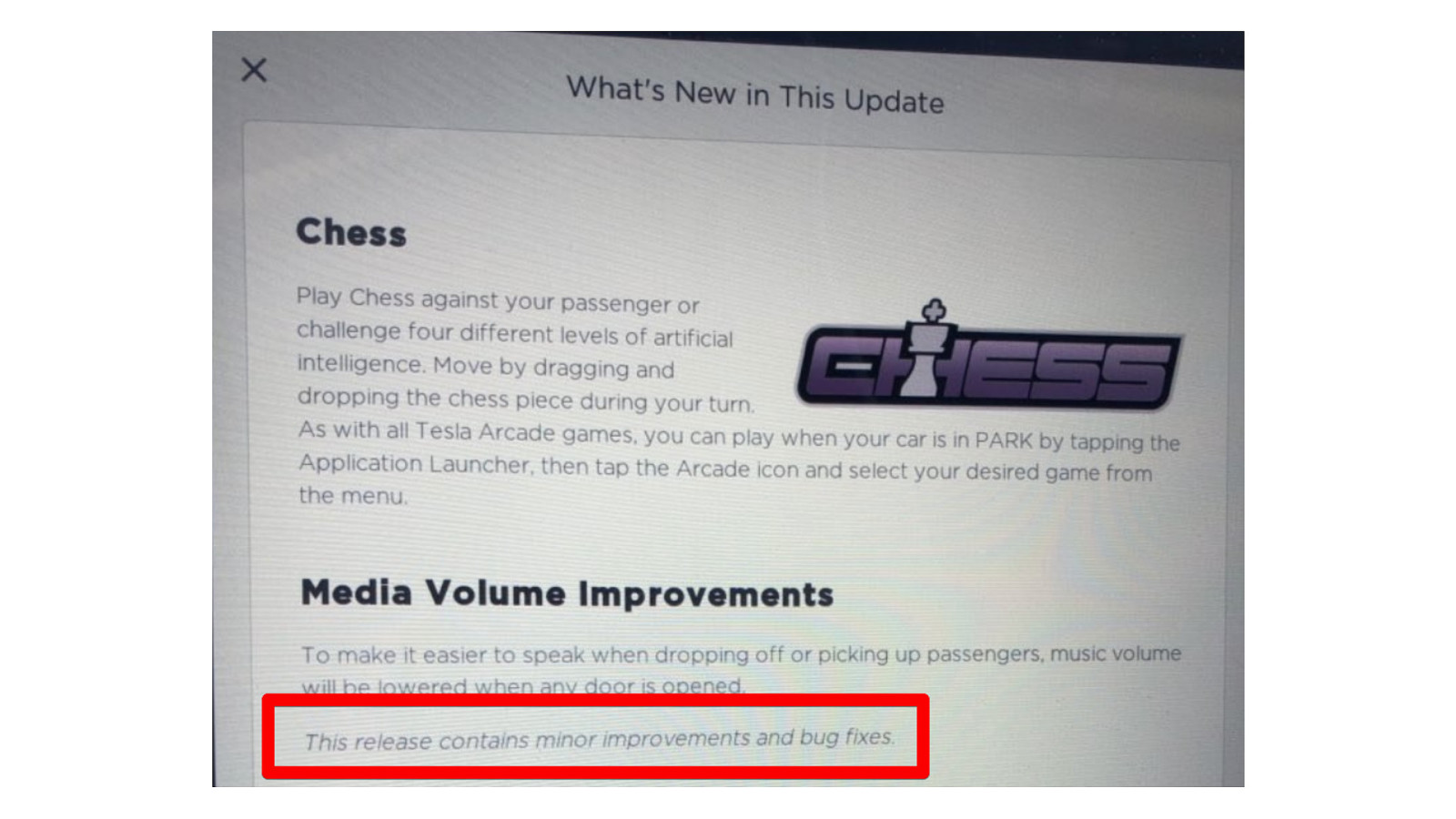
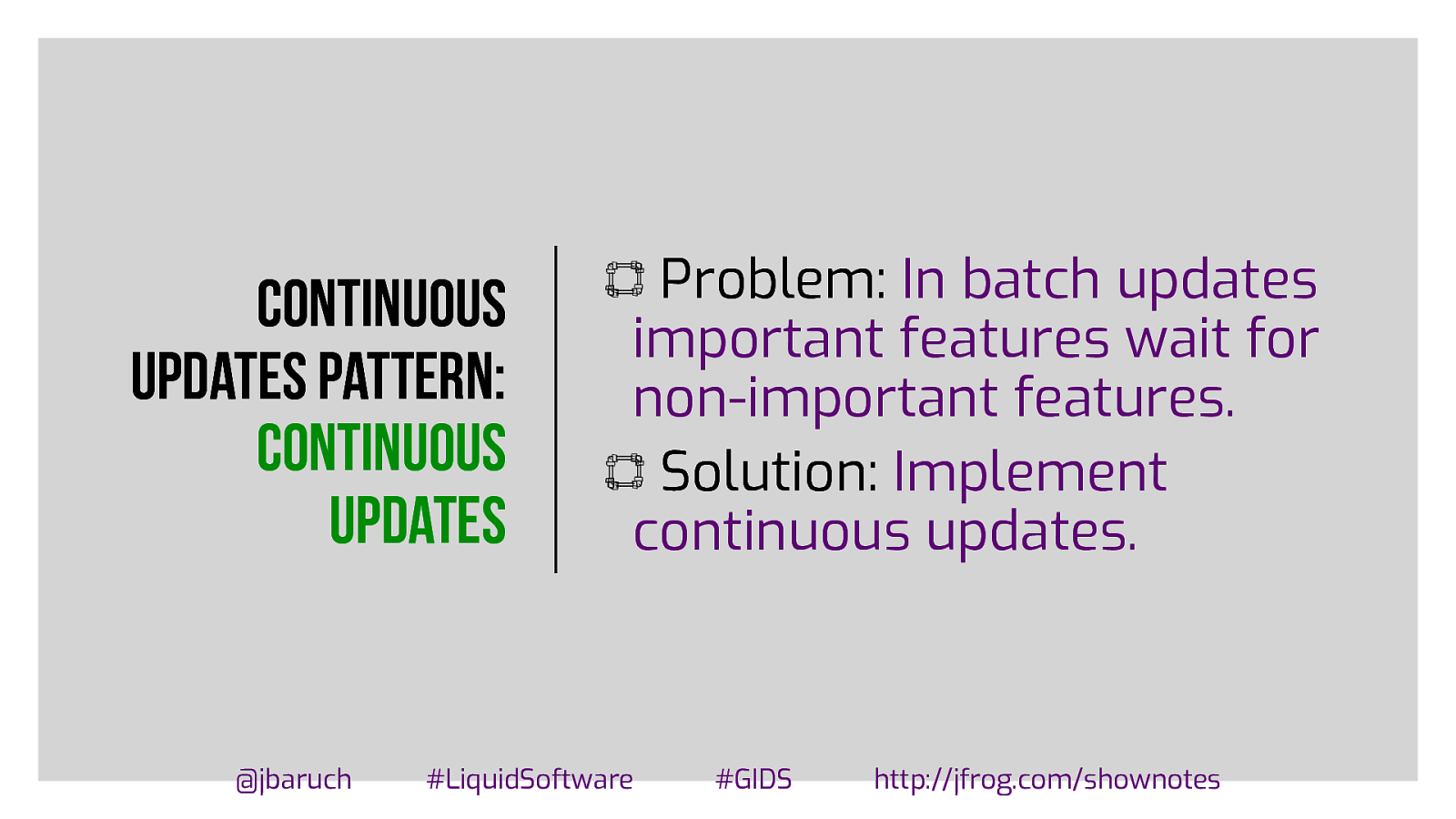
Continuous updates pattern: continuous updates @jbaruch Problem: In batch updates important features wait for non-important features. Solution: Implement continuous updates. #LiquidSoftware #GIDS http://jfrog.com/shownotes

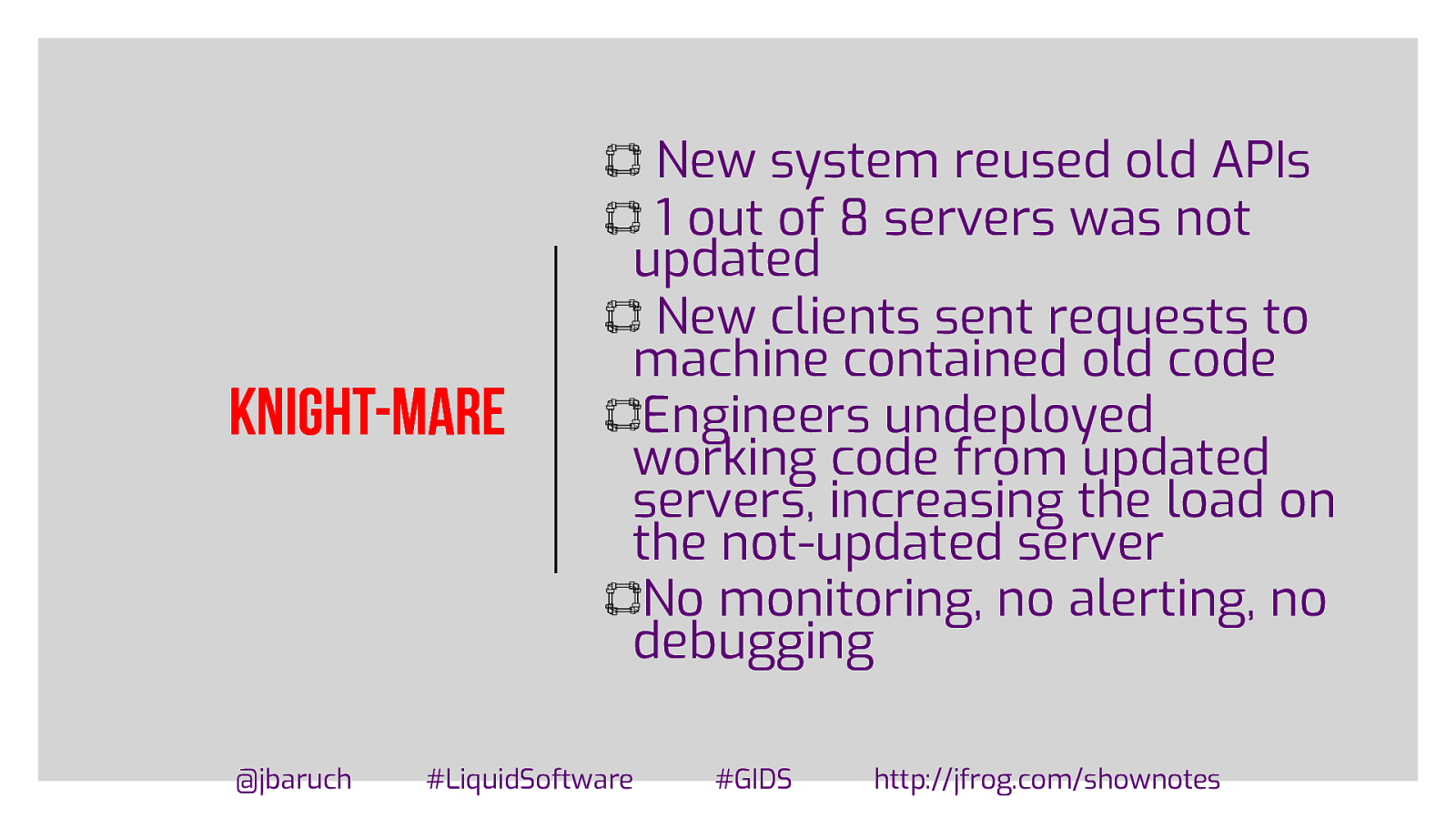
KNIGHT-MARE @jbaruch New system reused old APIs 1 out of 8 servers was not updated New clients sent requests to machine contained old code Engineers undeployed working code from updated servers, increasing the load on the not-updated server No monitoring, no alerting, no debugging #LiquidSoftware #GIDS http://jfrog.com/shownotes
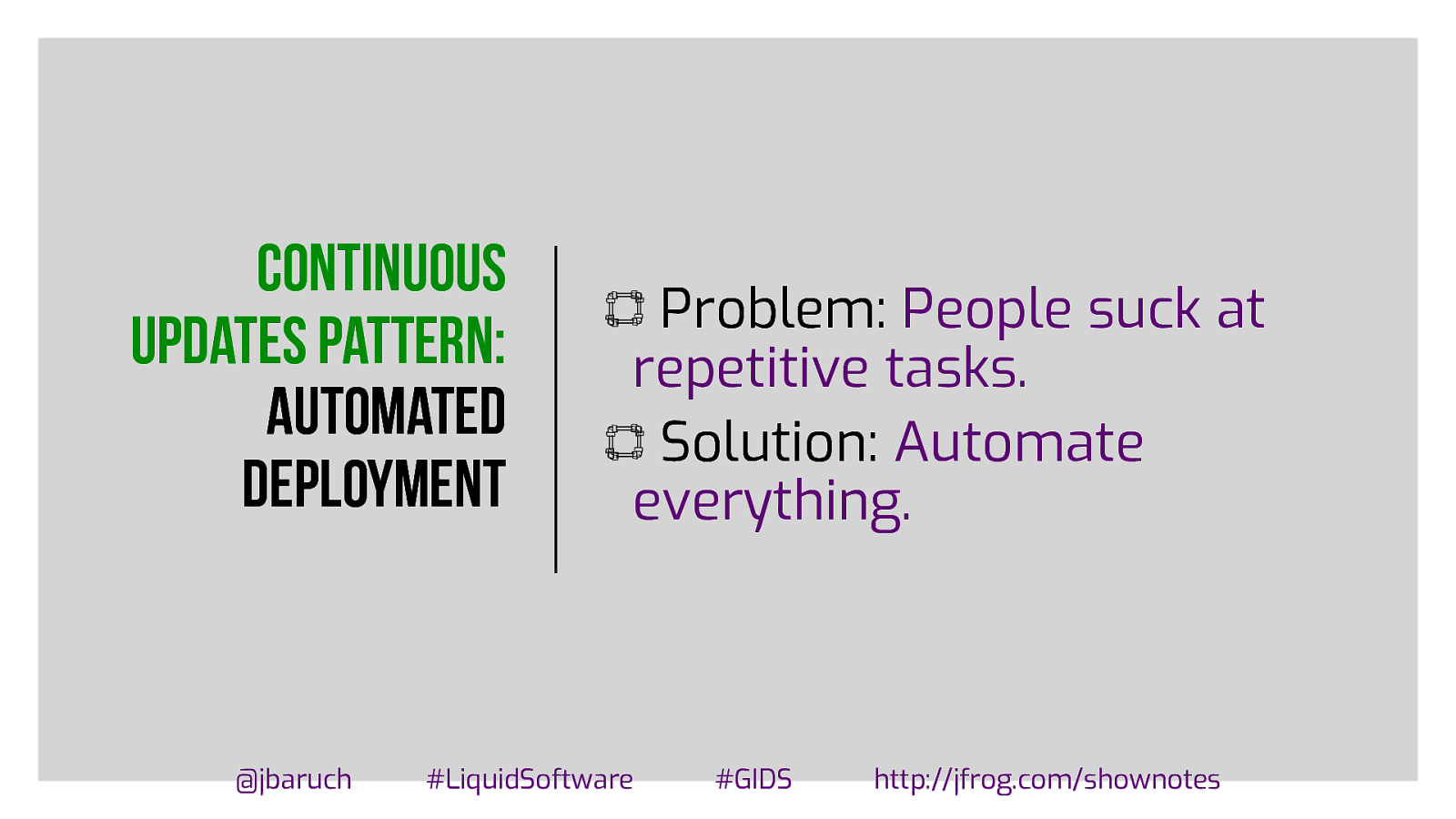
Continuous updates pattern: Automated deployment @jbaruch Problem: People suck at repetitive tasks. Solution: Automate everything. #LiquidSoftware #GIDS http://jfrog.com/shownotes
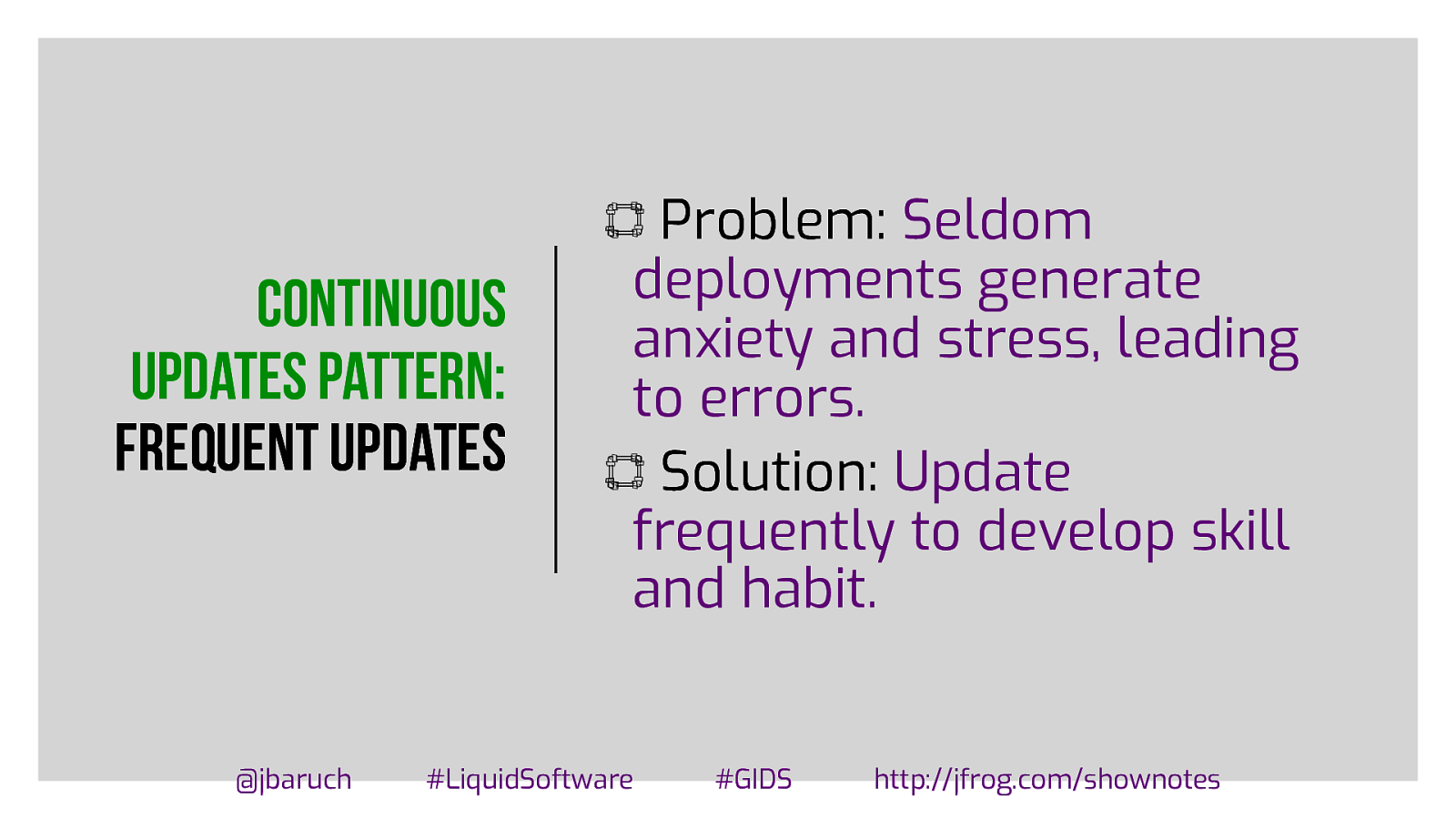
Continuous updates pattern: frequent updates @jbaruch Problem: Seldom deployments generate anxiety and stress, leading to errors. Solution: Update frequently to develop skill and habit. #LiquidSoftware #GIDS http://jfrog.com/shownotes
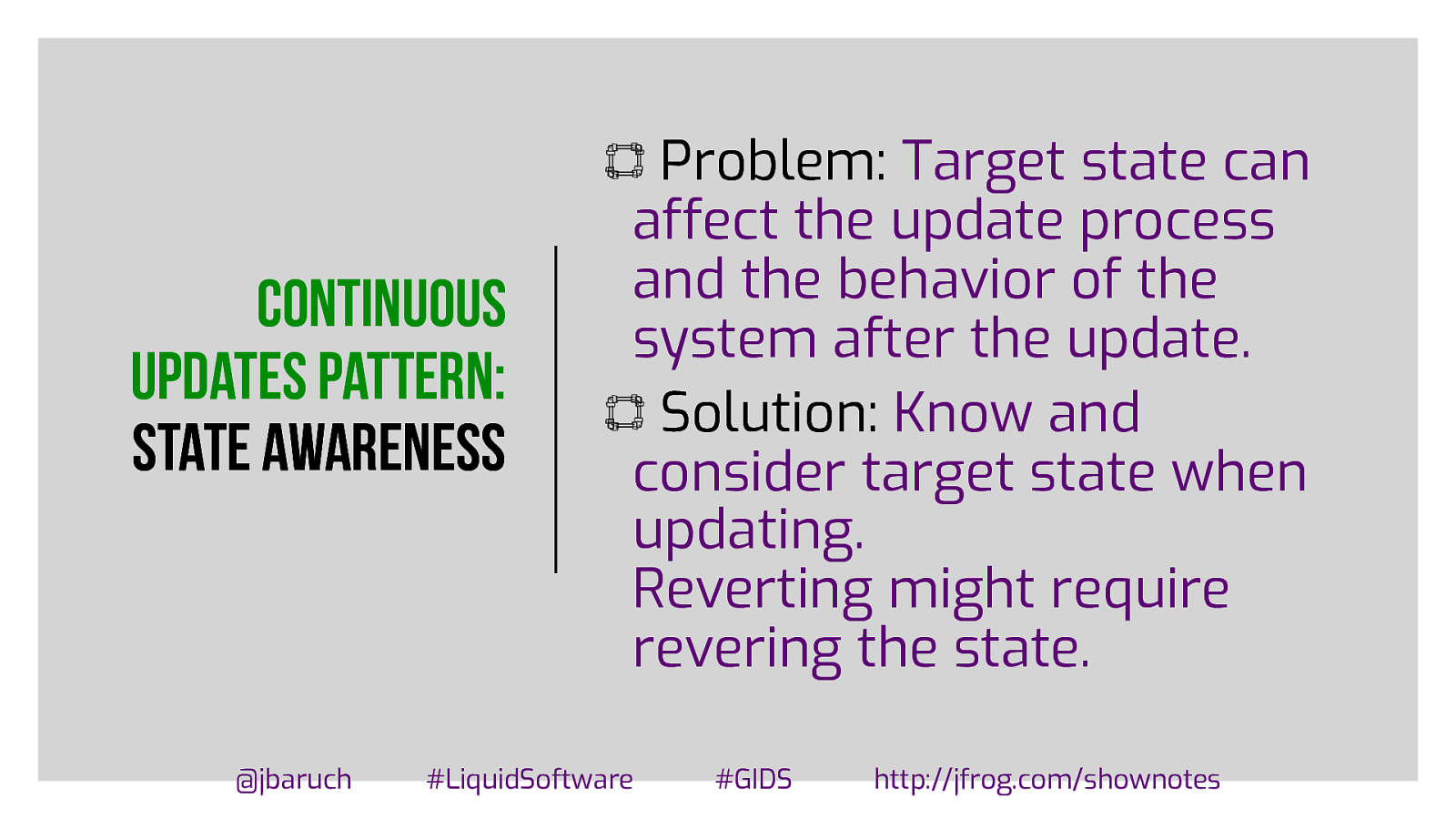
Continuous updates pattern: state awareness @jbaruch Problem: Target state can affect the update process and the behavior of the system after the update. Solution: Know and consider target state when updating. Reverting might require revering the state. #LiquidSoftware #GIDS http://jfrog.com/shownotes
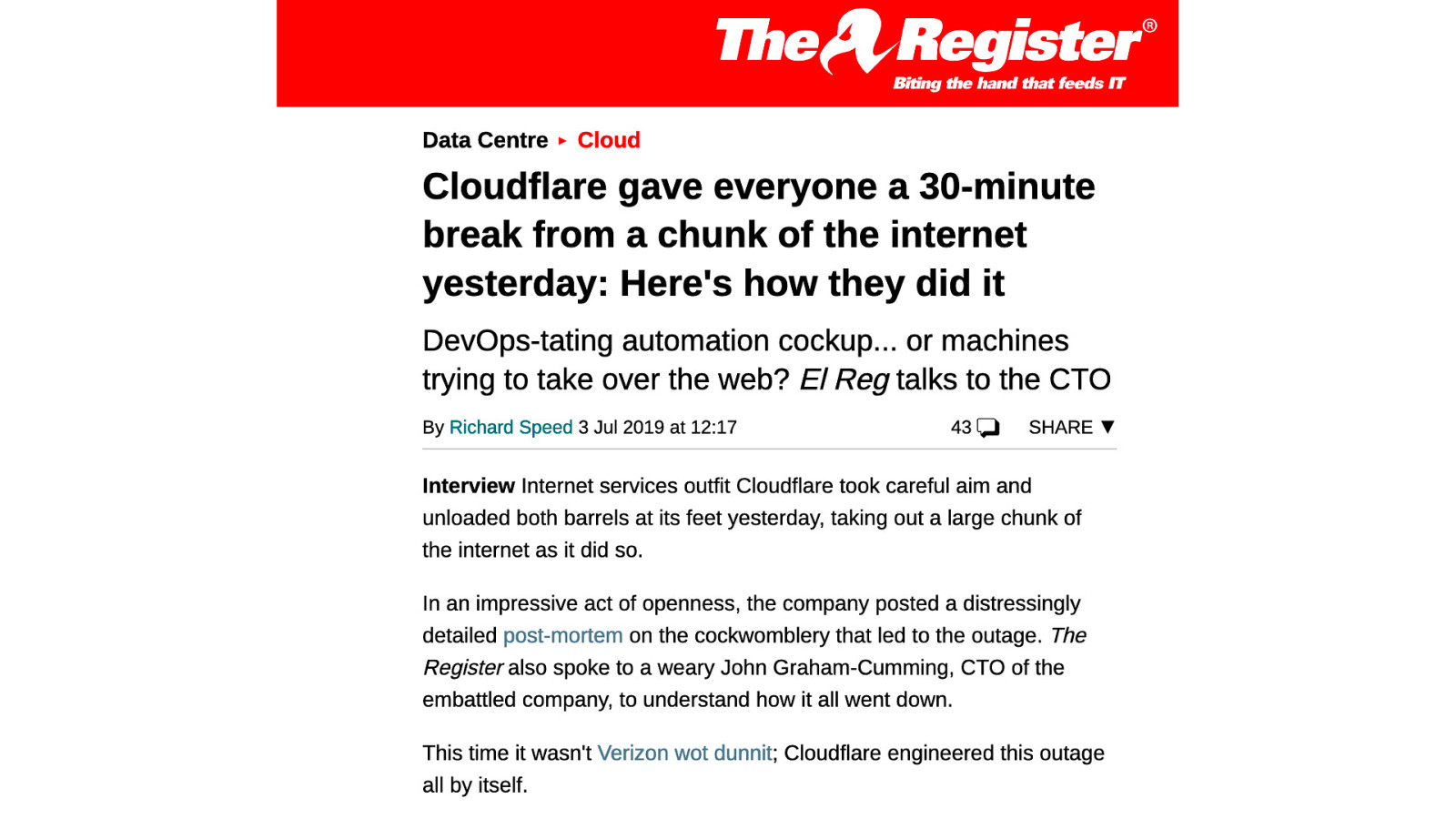
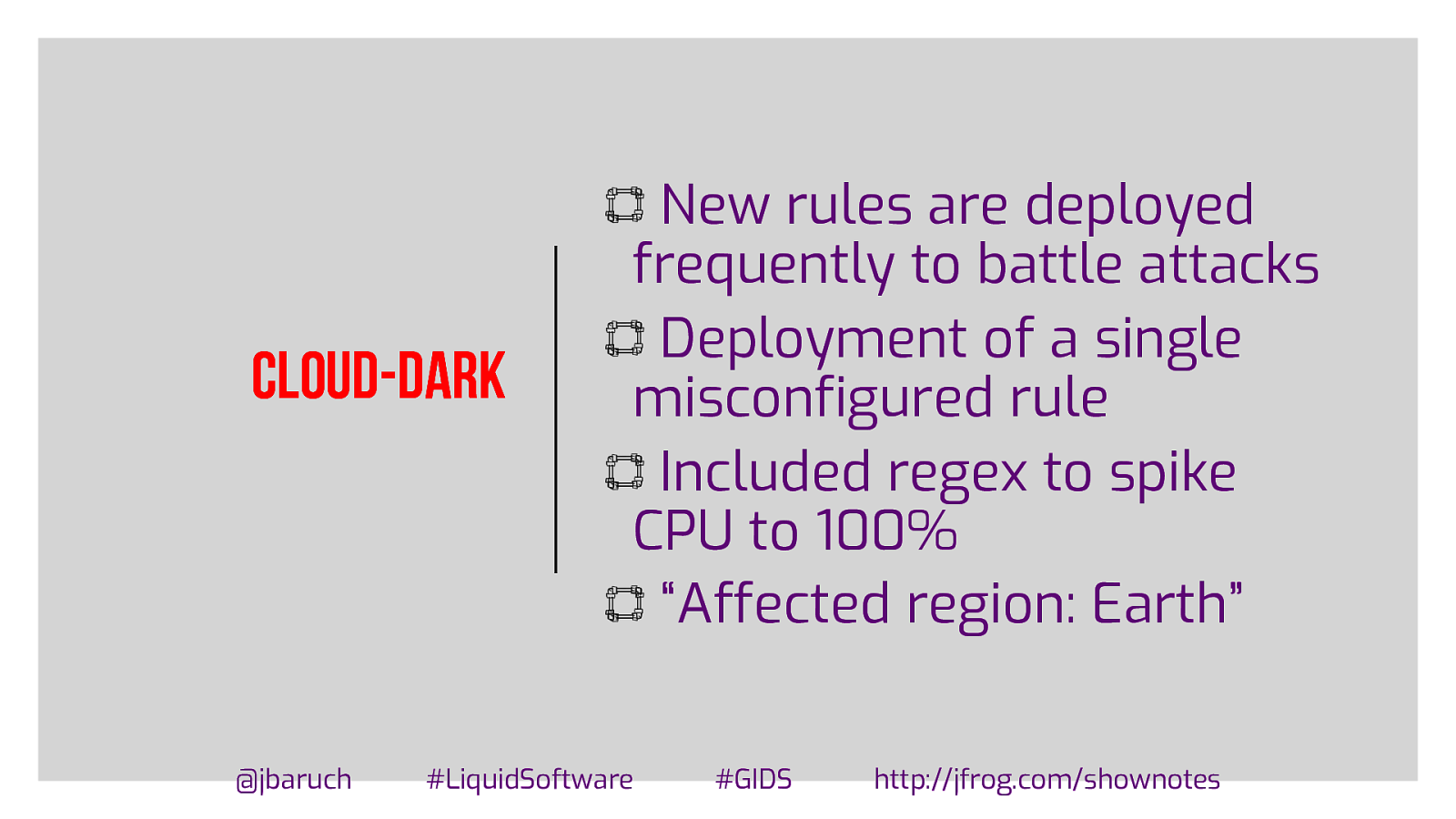
Cloud-dark @jbaruch New rules are deployed frequently to battle attacks Deployment of a single misconfigured rule Included regex to spike CPU to 100% “Affected region: Earth” #LiquidSoftware #GIDS http://jfrog.com/shownotes
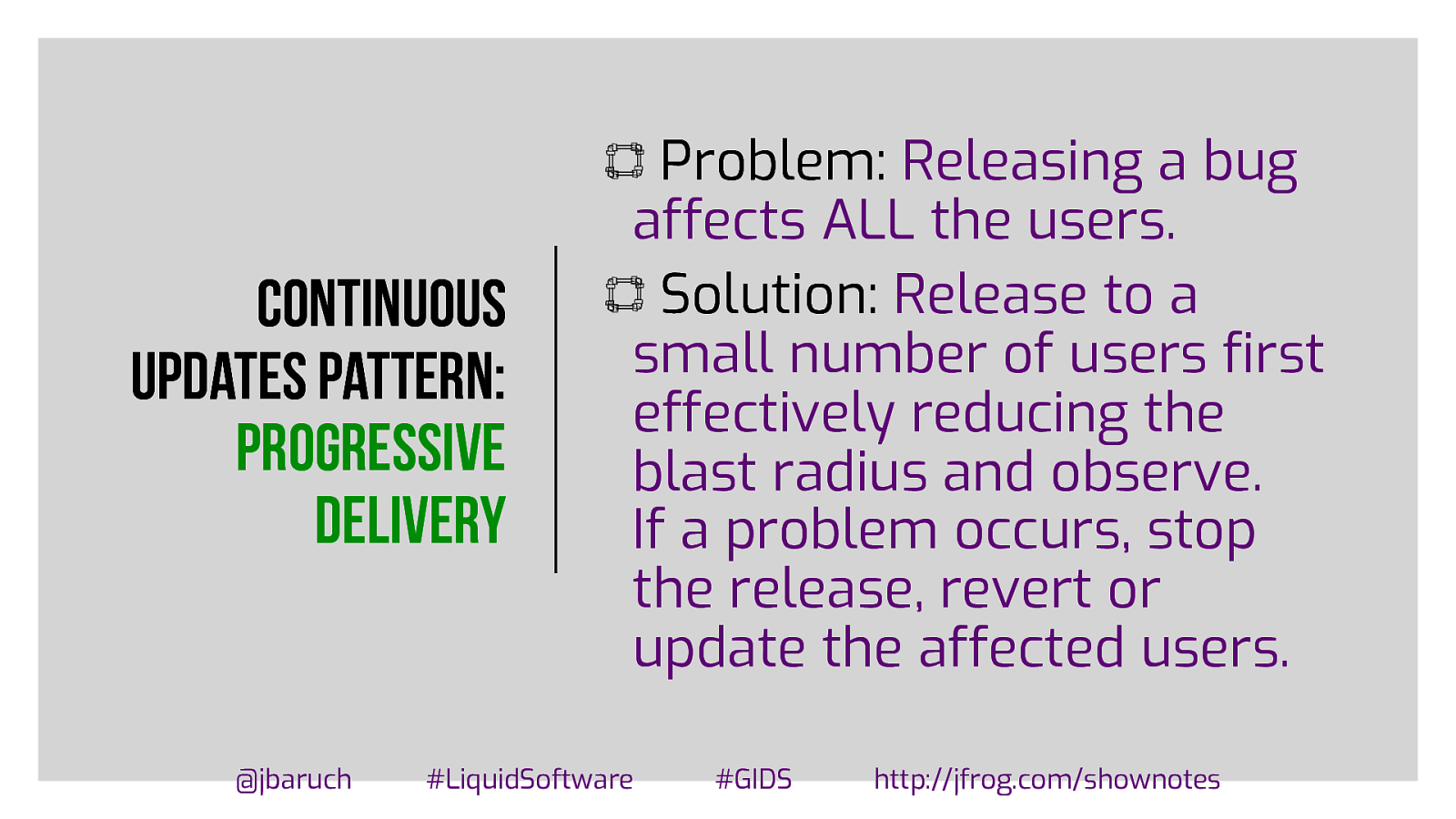
Continuous updates pattern: Progressive Delivery @jbaruch Problem: Releasing a bug affects ALL the users. Solution: Release to a small number of users first effectively reducing the blast radius and observe. If a problem occurs, stop the release, revert or update the affected users. #LiquidSoftware #GIDS http://jfrog.com/shownotes
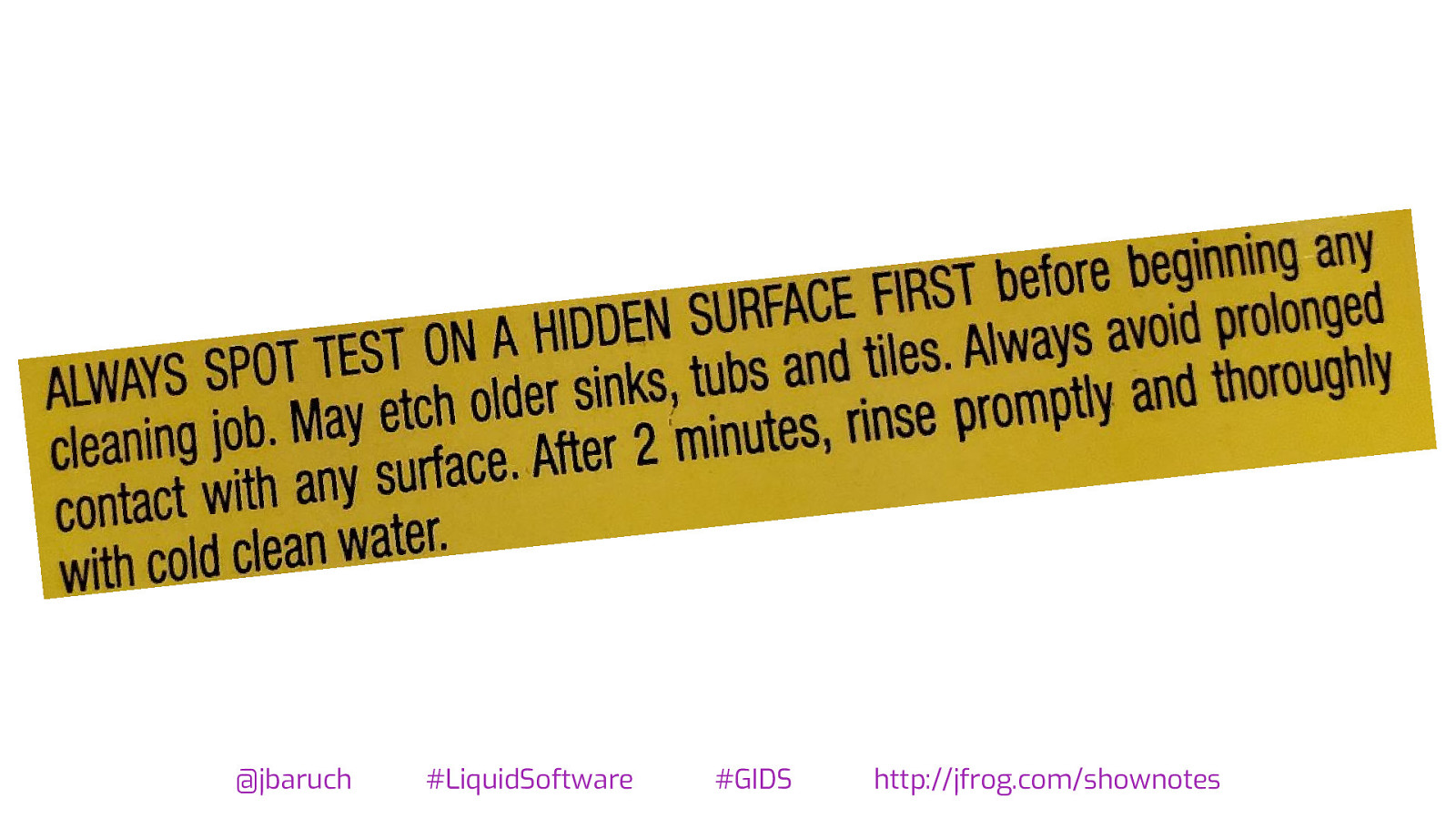
@jbaruch #LiquidSoftware #GIDS http://jfrog.com/shownotes
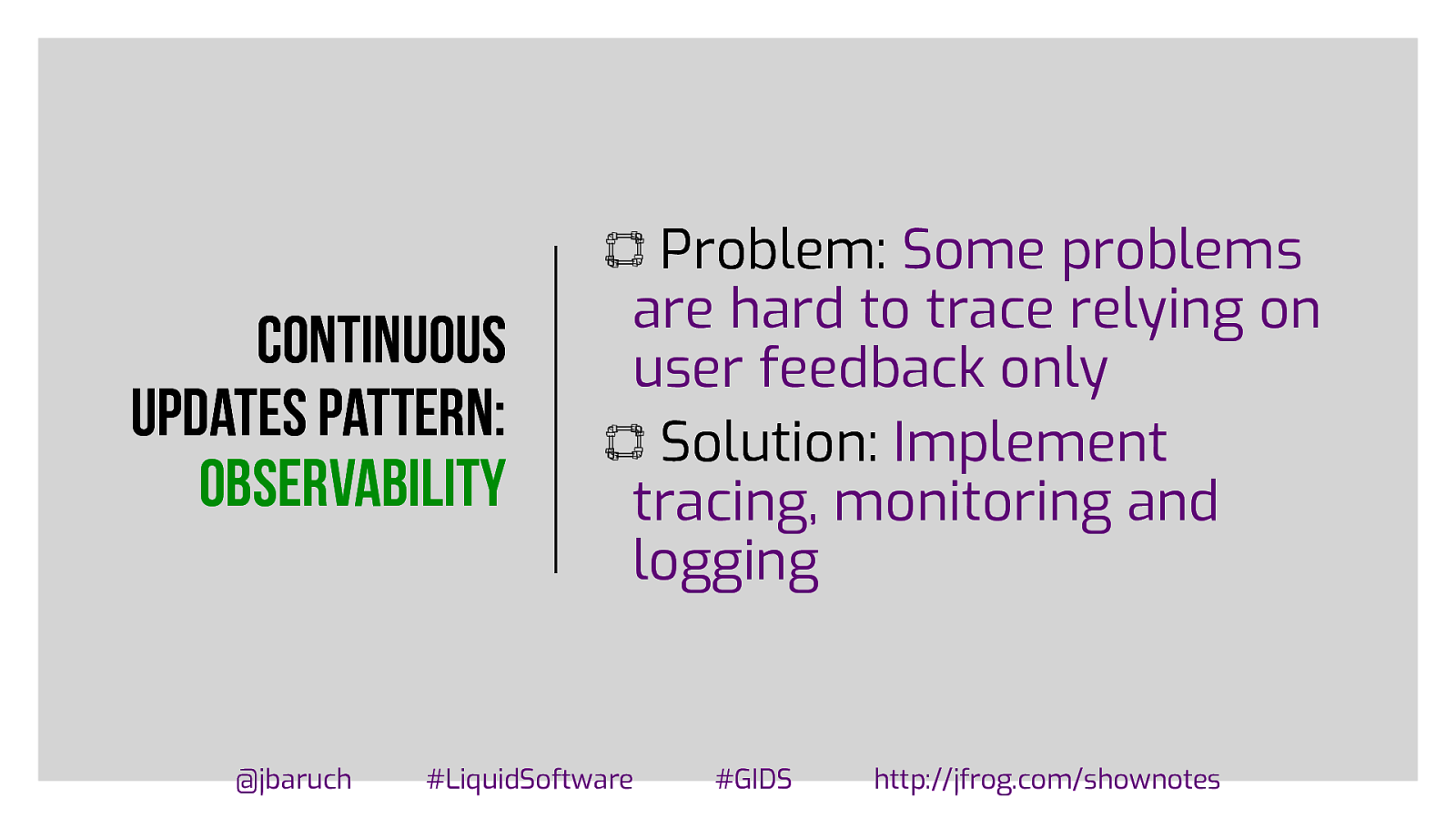
Continuous updates pattern: observability @jbaruch Problem: Some problems are hard to trace relying on user feedback only Solution: Implement tracing, monitoring and logging #LiquidSoftware #GIDS http://jfrog.com/shownotes
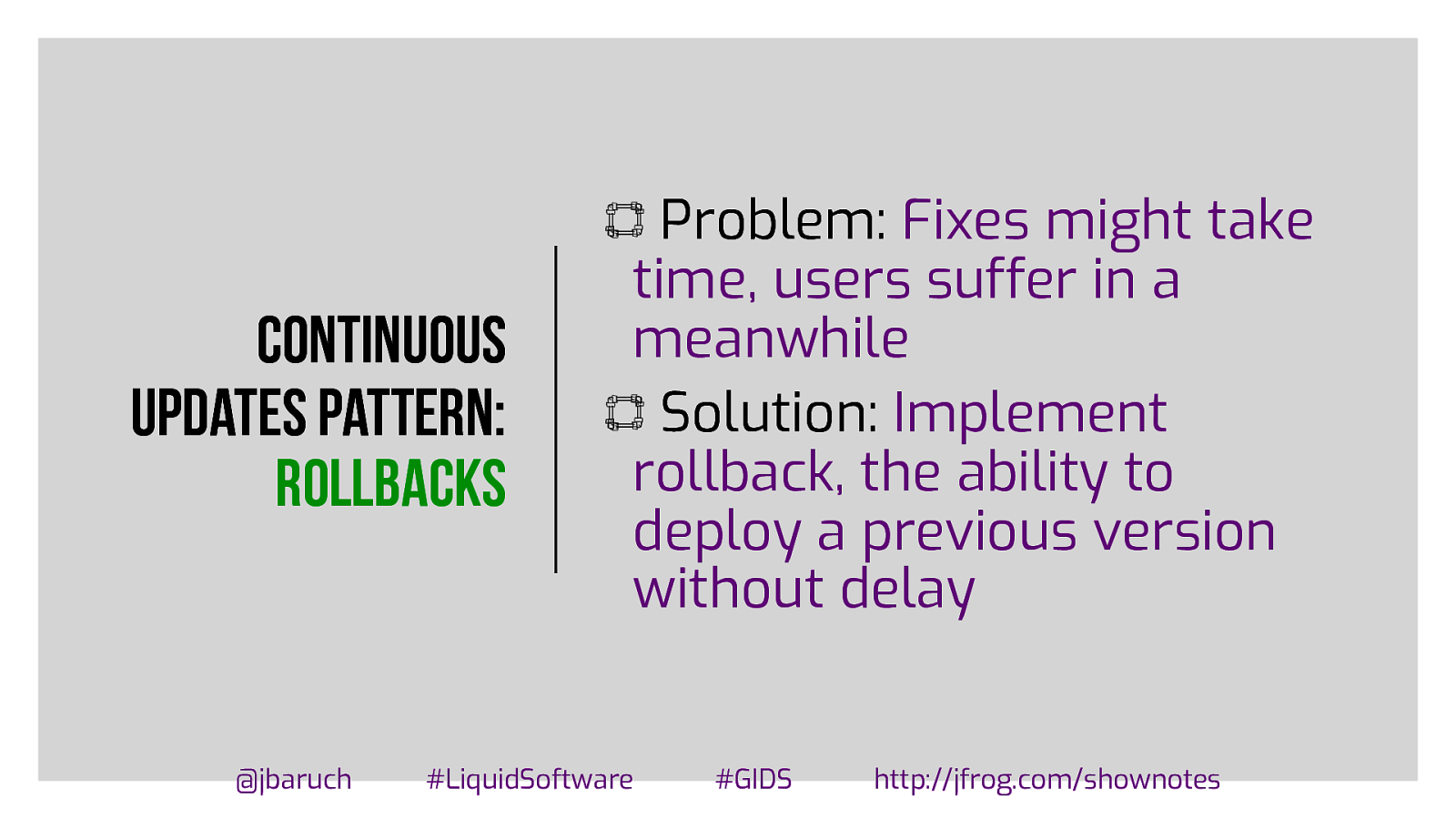
Continuous updates pattern: Rollbacks @jbaruch Problem: Fixes might take time, users suffer in a meanwhile Solution: Implement rollback, the ability to deploy a previous version without delay #LiquidSoftware #GIDS http://jfrog.com/shownotes
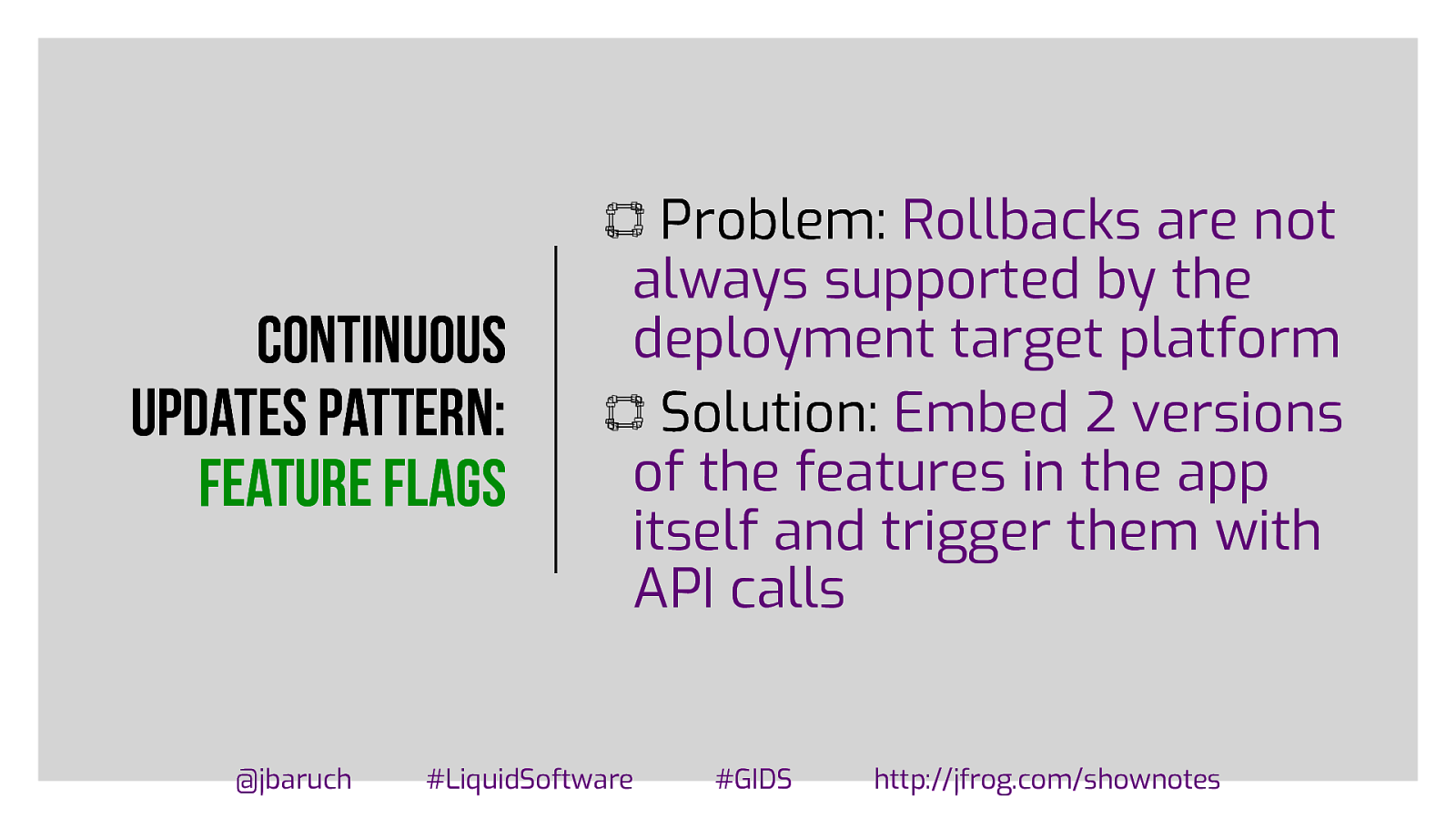
Continuous updates pattern: feature flags @jbaruch Problem: Rollbacks are not always supported by the deployment target platform Solution: Embed 2 versions of the features in the app itself and trigger them with API calls #LiquidSoftware #GIDS http://jfrog.com/shownotes
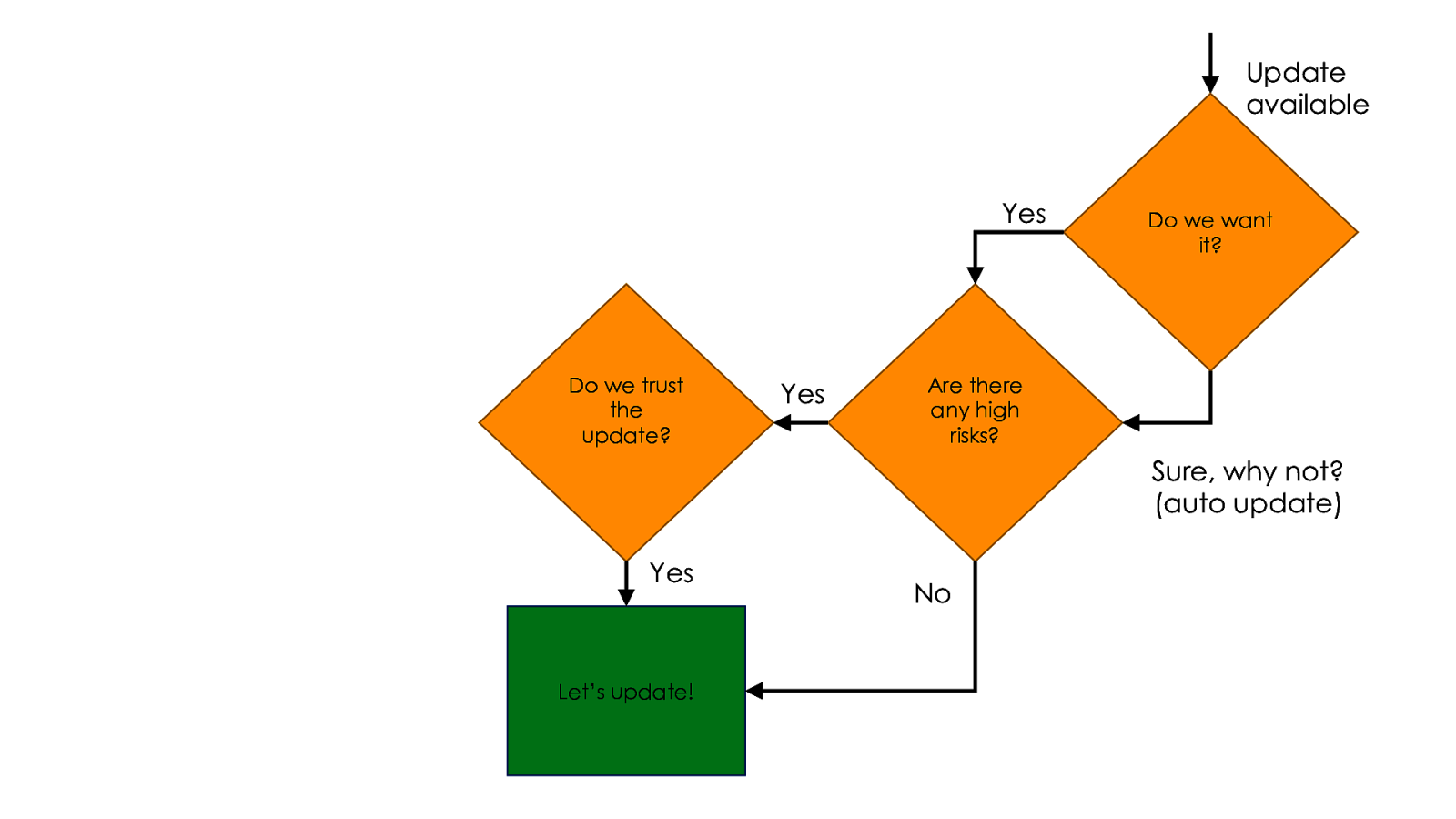
Update available Yes Do we trust the update? Yes Do we want it? Are there any high risks? Sure, why not? (auto update) Yes Let’s update! No
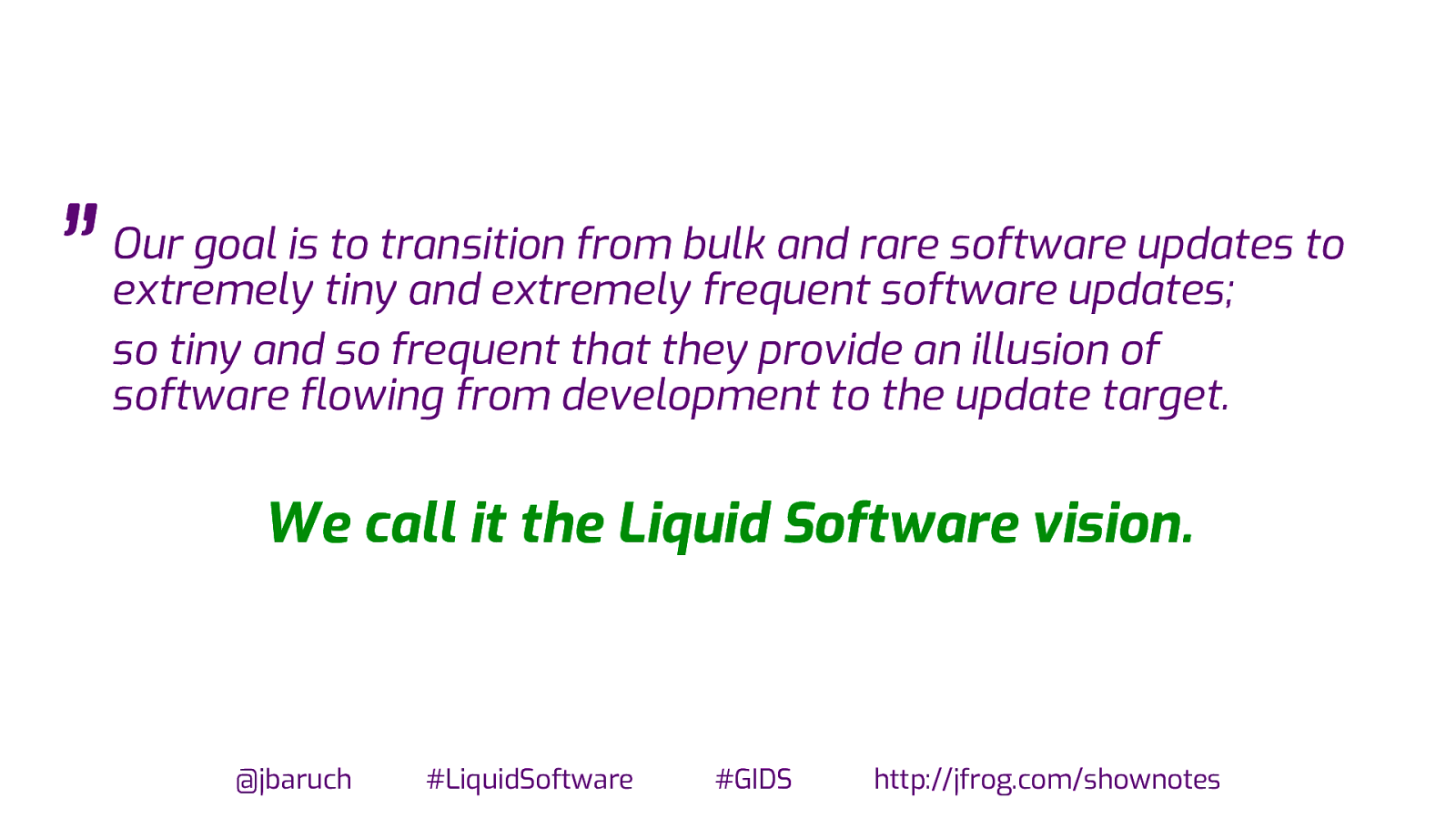
” Our goal is to transition from bulk and rare software updates to extremely tiny and extremely frequent software updates; so tiny and so frequent that they provide an illusion of software flowing from development to the update target. We call it the Liquid Software vision. @jbaruch #LiquidSoftware #GIDS http://jfrog.com/shownotes
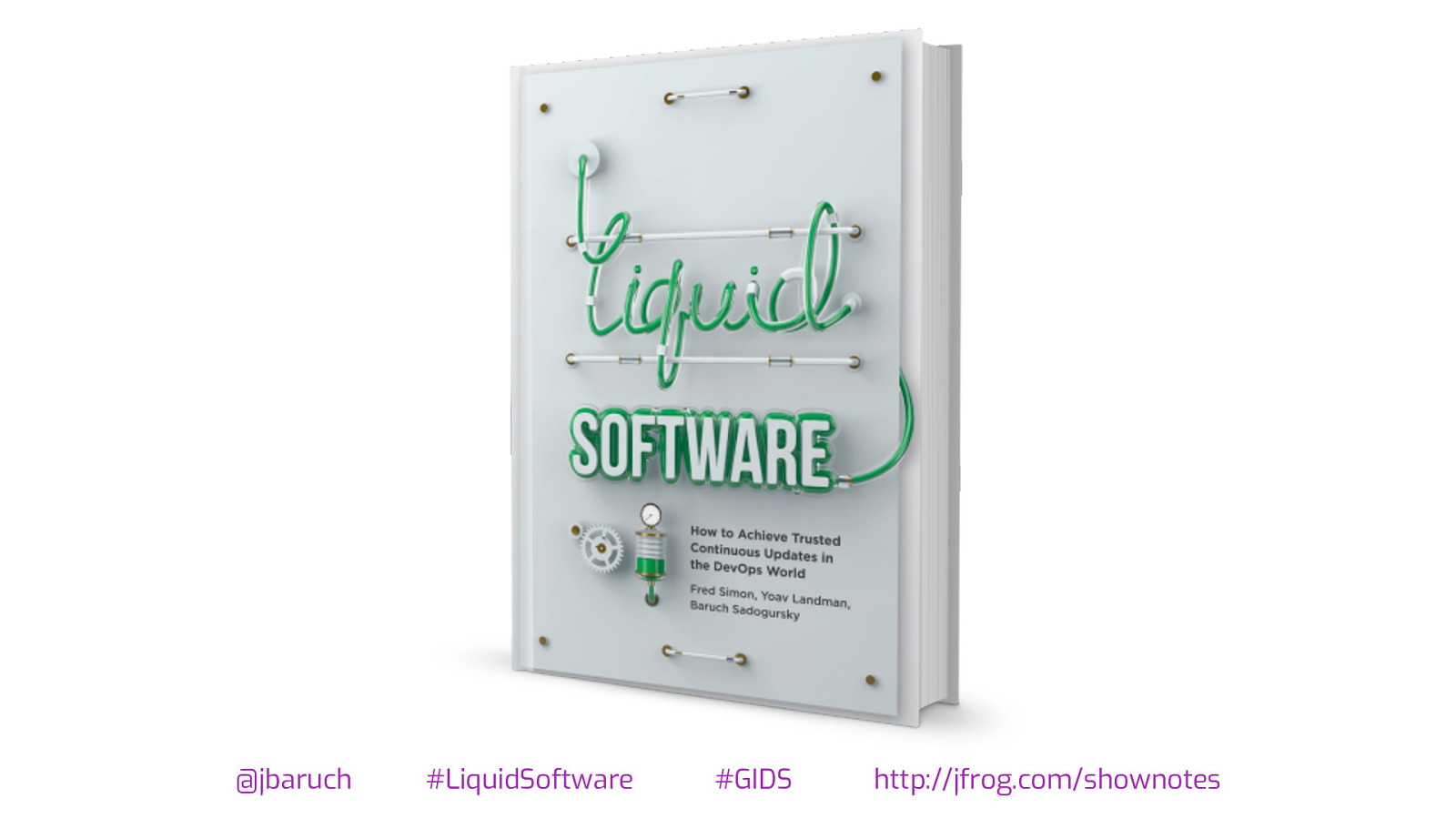
@jbaruch #LiquidSoftware #GIDS http://jfrog.com/shownotes
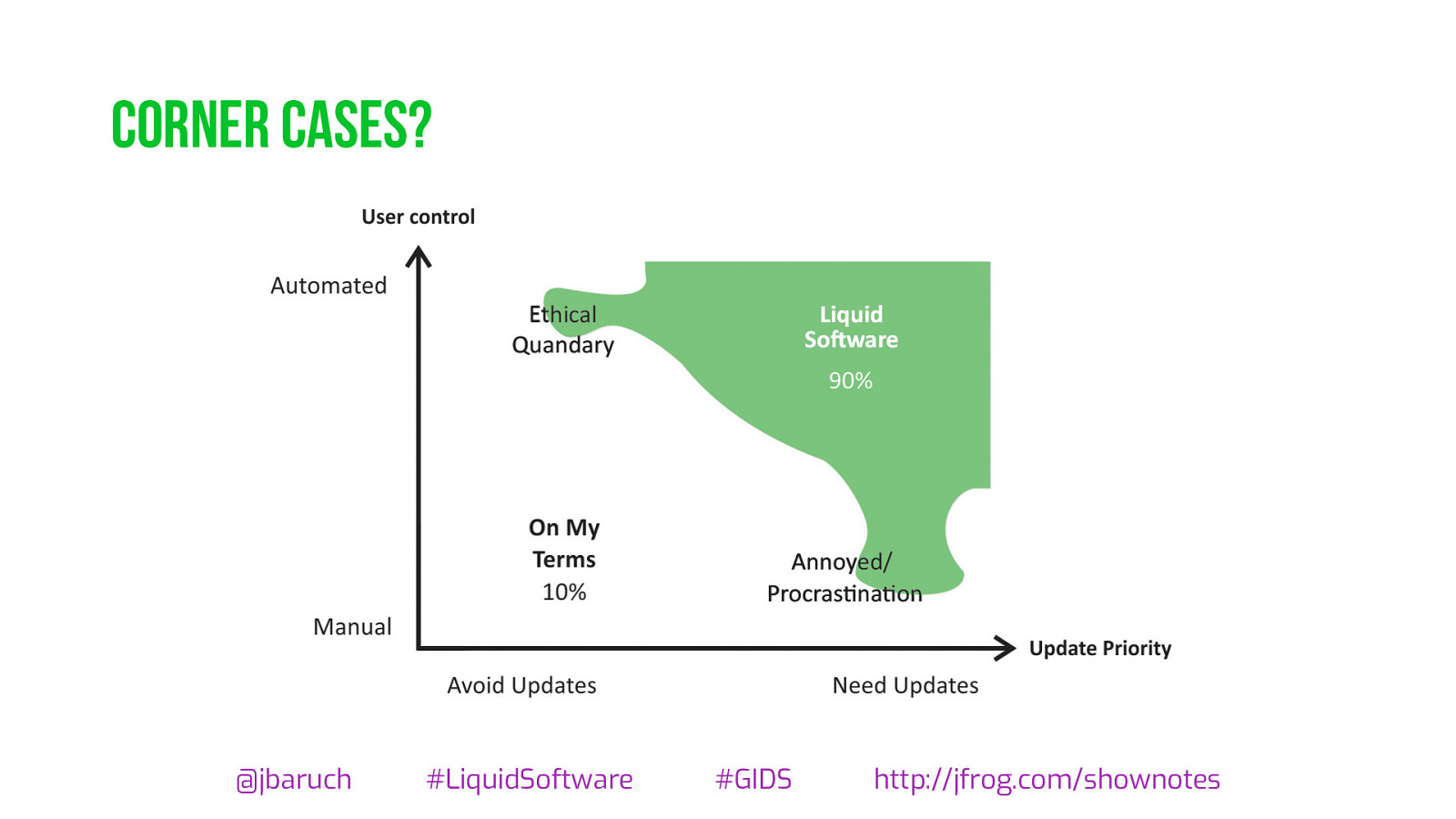
Corner cases? @jbaruch #LiquidSoftware #GIDS http://jfrog.com/shownotes


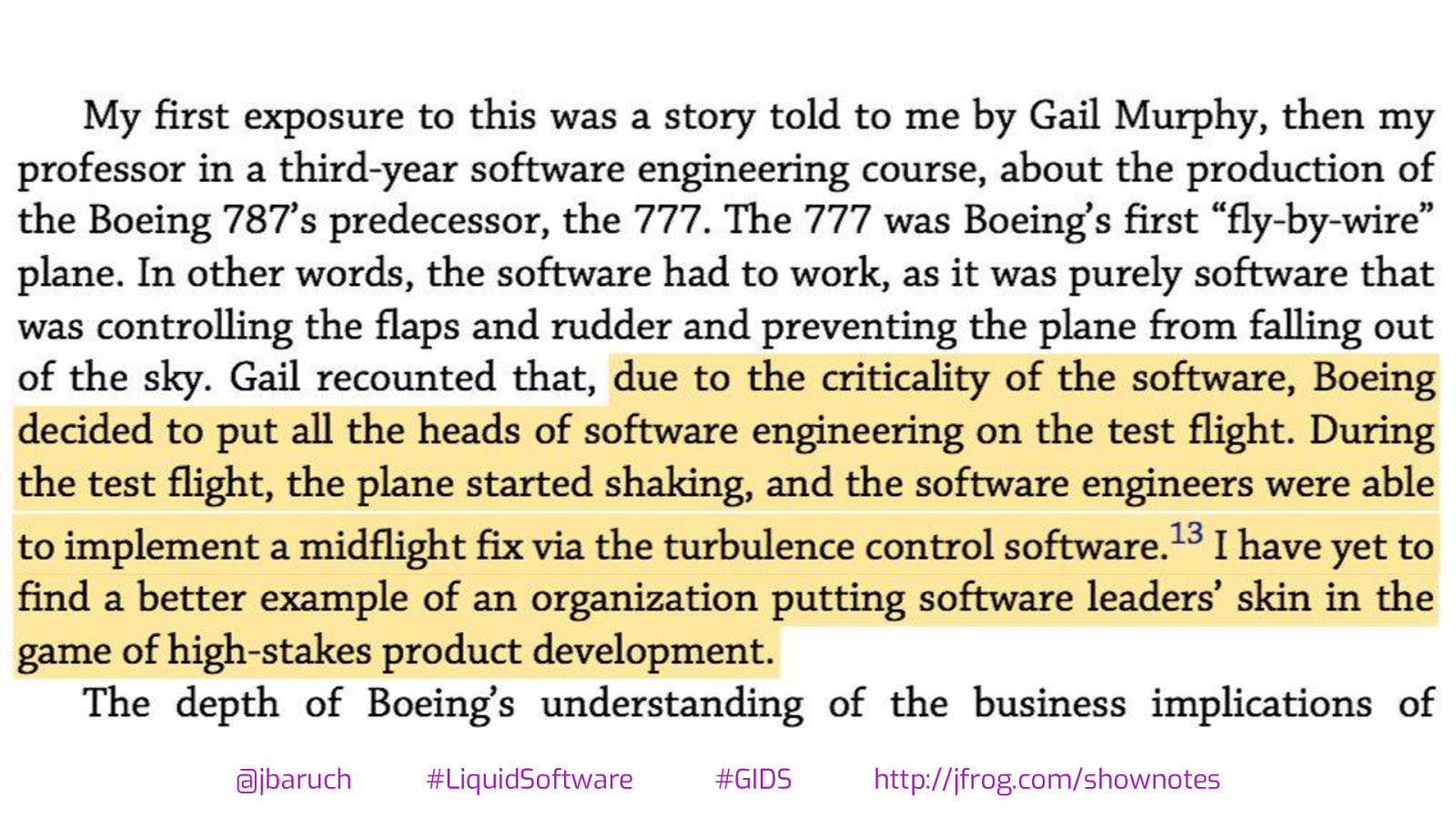
@jbaruch #LiquidSoftware #GIDS http://jfrog.com/shownotes
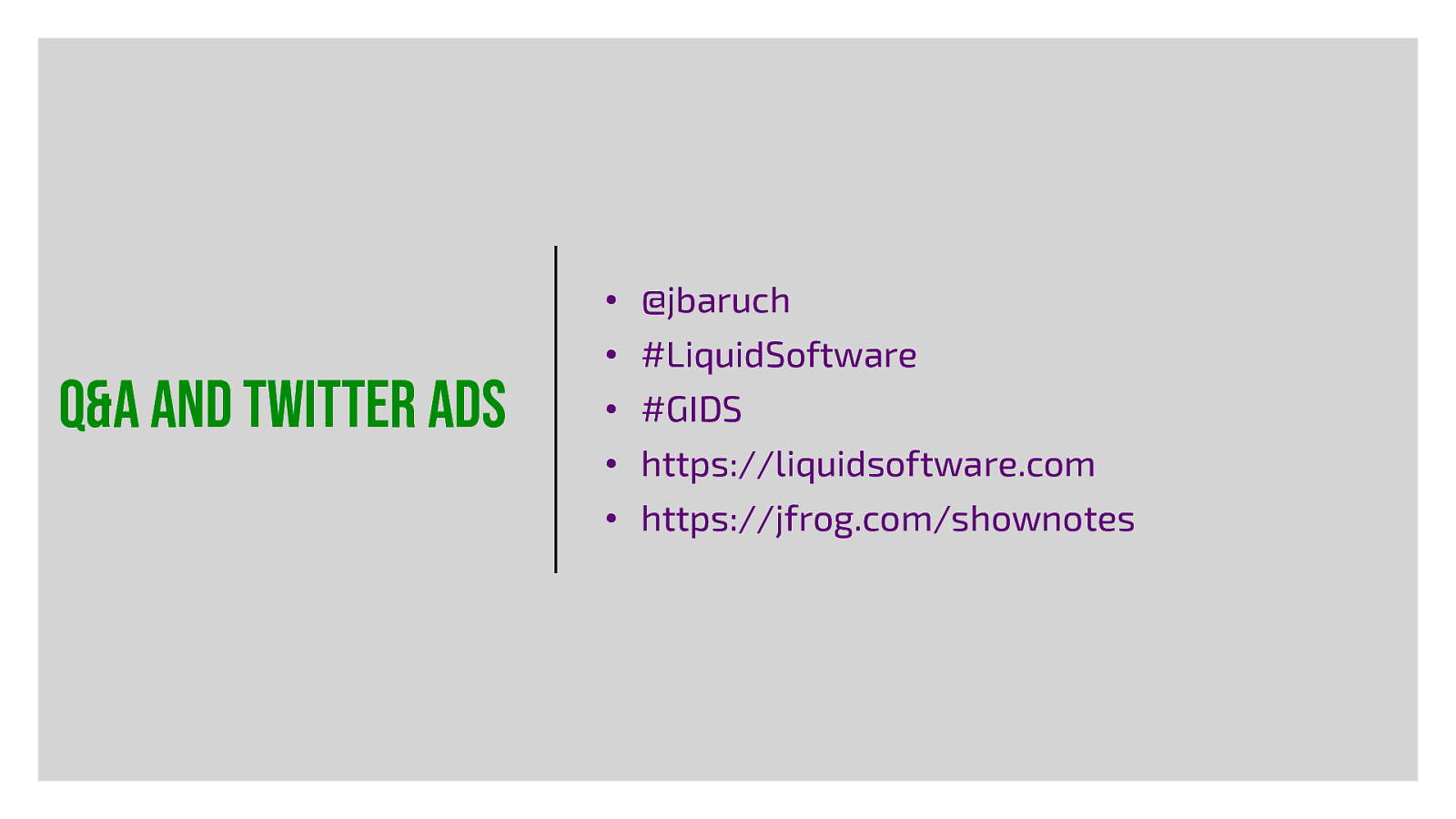
Q&A and twitter ads • @jbaruch • #LiquidSoftware • #GIDS • https://liquidsoftware.com • https://jfrog.com/shownotes
So, you want to update the software for your user, be it the nodes in your K8s cluster, a browser on user’s desktop, an app in user’s smartphone or even a user’s car. What can possibly go wrong?
In this talk, we’ll analyze real-world software update fails and how multiple DevOps patterns, that fit a variety of scenarios, could have saved the developers. Manually making sure that everything works before sending an update and expecting the user to do acceptance tests before they update is most definitely not on the list of such patterns.
Join us for some awesome and scary continuous update horror stories and some obvious (and some not so obvious) proven ideas for improvement and best practices you can start following tomorrow.
